
|
|
Shop @ Bassdozer Store | Lures, Rods, Reels | Boats, Motors, Electronics | Expert Articles | Reports | States | News | Forums | Tournaments | Clubs | Federations | Guides | Links | Books | Magazines | Surf Fishing | About Us | Terms of Use |
|
Note: The chart shows the running depths if not allowed to sink. They may be counted down to sink as deep as you allow them, to 20-30 feet or deeper. The exception is the 77 SU model which suspends only a few feet deep and does not sink deeper. The 66 and 77 SKs, however, will sink as deep as you allow them. So the depth that the SK models reach can vary from only a few feet to as many as 20 or 30 feet deep. They're versatile for shallow to deep. The 66 XH model can be counted down and fished deepest of all - or simply start reeling as soon as one hits the water, and it will remain in the depth range shown in the chart.
Flatt Shads look identical. The 66 sizes match the size of lipless lures ordinarily used by bass anglers. The 77 sizes are a little larger than usual, and appeal to a little bigger bass.
SEBILE Lures are labeled under the tail so you always know what model you've got tied on.
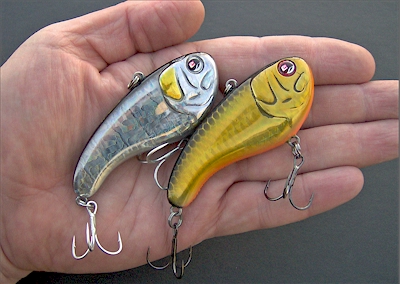 The Flatt Shad 77 SK (3/4 oz) on left looks identical to the shallow suspending 77 SU (1/2 oz) on right.
Now that you know how to tell the models apart, let's learn more about each one:
Tactics to TryHere are some of my favorite tactics to try: Before we get started, note that the Flatt Shads work more off vibration than they do rattling noise. True, they do make some rattling sound, but not as loud as most other brands of lipless rattling baits. The Flatt Shad's pronounced vibration, however, is its advantage. Straight Retrieves: You can simply cast and retrieve the Flatt Shad back to you, covering a lot of water that way. With all the Flatt Shads (SK, SU, XH versions), you can fish them on normal, fairly straight retrieves, and this simply can be productive. Fish it like you might otherwise use a spinnerbait, and the Flatt Shad's vibrating body will evoke a similar kind of reaction. All Flatt Shads will have action even when you go slow. The design concept includes a belly that is wider than the back. This causes big water turbulence on the sides and belly. That turbulence creates instability, which creates action. So you can go slow and can still have action. Whatever model or size of Flatt Shad, you can slow way, way down with the retrieve speed until you barely feel the lure throbbing in the rod handle.
Sinking Action: About the only time that Flatt Shads won't have a lot of built-in action is while they sink. They are designed to sink perfectly horizontal so they won't spin or foul the line while they sink. They can be popped with the rod tip as they fall, or you can shake the line. As soon as you pop or shake them, they'll instantly start wobbling as long as there is even slight line pull to activate them. Burning: Another tactic with all the Flatt Shads (SK, SU, XH versions) is to try burning a Flatt Shad by reeling rapidly, That can cause fish to react and chase after and snap at it instinctively. This burning can be more effective at times than a more placid pace. This seems logical when bass are acting aggressive and chasing, but burning can be the ticket anytime. Even when fish seem lethargic or inactive, sometimes burning a Flatt Shad may be the only way to trigger an instinctive bite. Whipping: Yet another great approach is to whip a Flatt Shad (SK, SU, XH), by sweeping the rod tip quickly up from water level to say 11 o'clock, pausing slightly at the top of the sweep, and then reeling in the slack on the downstroke as you lower the rod to whip again. The whipping tactic gives you the fast lure movement on the upstroke that causes the instinctive reaction - plus a falling hesitation each time you reel down to match the sinking Flatt Shad's fall on the downstroke. With this whipping tactic, be prepared for hits that come right at the top of the stroke, as soon as you start following the lure down with the rod tip. It's a little different in the 77 SU's case, you get a suspending, standstill hesitation each time you pause and reel down with the rod tip in order to make the next whipping stroke. Most often, bites will come during this suspended pausing moment, and you may not even detect a fish is on until you go to whip again. Managing Slack Line: One time-saving tip that can salvage precious casts for you, if you let these fall on a slack line or if one tumbles on a cast, the line can get tangled in the hooks. Ninety percent of the time, you can shake it and it will untangle without reeling it in. The way this works is to shake it when it's sinking. You can shake the tangle off the hooks 9 times out of 10 as you let it sink. If you pull on it as you shake, forget it. So just shake it loose on a semi-slack line as it sinks. You'll be surprised how effective this works once you get the knack. Of course, the best way to avoid tangles is not to let them happen. Often it is the angler (not the lure) who causes a tangle by letting his lure sink on too slack of a line. So always manage the slack and be conscious to keep slack out of the system. Once you start doing this, it becomes natural and easy. You do need to let the baits have a little freedom of action that is enhanced via a semi-loose line, but giving total slack never helps anything, can cause you to miss undetected bites and slack is what makes tangles. So always follow a sinking lure down with your rod tip on a semi-loose line, and you will be far more productive and indeed you'll certainly catch more fish. Following a Falling Bottom: Now that we've talked about managing slack, one more Flatt Shad technique with the SK and XH models is to 'walk' the lure down any sloping bottom, be it the side of a cliff, the sloping tip or sides of a point, a rounded hump, or gradually-falling creek channel - most any sloping shoreline or bottom. Simply cast to where you want to start, meaning the shallowest part you want to fish is where the lure should land, and then simply hold the rod tip up around ten o'clock and follow the lure's sinkage down with the rod tip, so the lure has a semi-loose line to develop falling action. When the rod tip gets close to the water, lift gently again to 10 o'clock and follow the lure's descent back down until the rod tip nears the water again. You can let the lure sink further or 'count it down' at the very beginning of the cast until it gets to the depth you want to start at. Also, any time during the retrieve, just wait longer until it hits bottom or falls deeper. But basically perform this lift-and-fall tactic for the entire retrieve, thereby following the contour of the sloping bottom back to the boat. When you whip it, it moves real quick and then it slows down, stops and starts to sink like it can't continue any longer. Many hits will come on the falling portion as you follow the lure down with the rod tip. Jigging the Bottom: Another tactic for when bass are on or close to bottom in deep water, the best tactic is letting it hit bottom and then jigging it a few inches off the bottom. This works with the SK and especially XH models. Just let the Flatt Shad hit bottom and then continually jigging it a few inches off the bottom. Just lifting and letting it fall back to bottom, almost the same as vertical jigging a spoon in deep water. However, very small flicks or draws of the rod tip - only a couple of inches - are all that's needed to get bit this way. So, you don't necessarily need to rip the Flatt Shad a few feet and let it fall (as usual with a spoon). True, that may work with the Flatt Shad, but what also works is just moving the rod tip a scant few inches (3 or 4) and letting the Flatt Shad hit bottom - and pause. Fish will scrape it off the bottom. With thin braided line, I routinely jig the Flatt Shad up to 50 feet deep. Hovering Above Bottom: Another method to fish deep, snaggy or rugged, irregular bottom, is you can let a Flatt Shad SK or XH hang straight down on the end of your line barely above bottom (the closer the better). Again, just pop it once or twice to lift it only a few inches with the rod tip. Then let it free fall those few inches. You just raise it a little as you give it one or two gentle pops or shakes, then lower the rod tip and wait to feel a slight tug as the line comes tight after the lure falls. In this case, the tug is not the lure hitting bottom. The tug is the lure coming tight on the end of the line so it hangs very close to (but not on) the bottom. Just wait after you feel the lure tug the line tight, which is when you will get bit - during the pause. In this way, the Flatt Shad hovers above the bottom debris, avoiding a lot of contact with snags, and it also stays more visible to fish by not falling down below sight. It's kept raised slightly which helps more fish see it better from further distances. Ripping the Grass (with SK models): SEBILE pro-staffer and major tournament winner Stephen Johnston was one of the first anglers in Texas to recognize the value of the Flatt Shad 77 SK. At the Texas Stren tournament at Sam Rayburn in February in 2007, Johnston won that tournament by 11-1/2 pounds, and that was fishing against 200 pro anglers. What he was doing, he was throwing the Flatt Shad 77 SK so that it would get down and get hung in the grass, and then just rip it out of the grass to get that reaction strike. That's how Johnston was using it when he won the Stren Series Texas Division event on Sam Rayburn Reservoir in February 2007. However, any lakes that have hydrilla, or any kind of eel grass, whether in Texas or along the whole southern coast from Louisiana, Mississippi, Alabama, all the way to Florida, that big Flatt Shad 77 SK is a hard bait to beat in the grass. "Everybody down here, we throw lipless rattle baits quite a lot. The whole deal with the Flatt Shad 77 SK is totally just the action of the bait. The movement and vibration is totally different from anything else and it puts off a total different sound than any other lipless bait out there. These fish, they hear so much noise that I think they get used to it, and then when something comes by with just a total different sound, they're all over it. The SEBILE Flatt Shad is one bait I will always have tied on a rod while fishing the heavy hydrilla lakes around here," says Stephen Johnston. Ripping the Grass (with 77 SU model): The 77 SU suspends no more than a few feet deep, making it ideal for shallow cover situations where the other models of Flatt Shads (which sink) could easily get hung up. However, if the 77 SU does get hung up in brush, grass or whatever momentarily clutches onto it, just rip it free so the 77 SU pops loose and ... do nothing (which is when you'll get bit). The 77 SU will rip free, wiggle a little ways and then pause perfectly motionless. That's something that other sinking lipless baits cannot do. Slow-Swimming the Grass: Sebile pro-staffer Cajun Phil Broussard also favors fishing the Flatt Shad in grass. He uses the 1/2 oz 66 SK more than anything else. He cuts the bottom-facing tine off both the belly and tail treble hooks, and this lets Cajun pull the Flatt Shad very slowly through grass. "I throw the Flatt Shad up into the grass and pull it slowly through the grass, and they just step out of there and they hammer it," smiles Phil. With the downward-pointing hook points removed, that leaves just the two upward points, and those actually tuck up under the belly, one on each side of the belly. He also cuts the downward-facing point off the tail treble too, so you have no hook points facing downward. "It's just a steady retrieve I make right through the grass. I don't have to rip it back. I don't have to hold my rod tip way up high and reel it real fast like I would have to do if it had all the hooks hanging there. I can actually throw it in the grass and work it slow through the grass, and not worry about it hanging up. That's my secret bait!" says Broussard.
Suspending Action (with 77 SU model): The Flatt Shad 77 SU (suspending) is unique in that it has an almost neutral buoyancy. In the water, the 77 SU will barely sink. Instead it suspends no more than 2-3 feet deep, making it ideal for shallow cover, for fishing over submerged weedbeds and through the tops of brush. If you hold the rod tip low and reel steadily, even burn it fast, it will not get more than 2 feet deep. So it is great for shallow water, for fishing over submerged weedbeds and through the tops of brush where other Flatt Shad models can't easily go. When fish are hiding in thick, shallow cover where they are holed up waiting to ambush bait, you can work the 77 SU right up to a bush, and then just stop it right where you think is best, right in front of the bush where you think a bass is holed up. That's what the 77 SU is made for. When you let it suspend there, that truly antagonizes them. It's not like something that's swimming by, that's passing through. It stops and stays right in front of their bush. So it's kind of like sitting there in their space, and they're going to attack it for that reason. That's a reaction strike you can really only evoke with a neutrally suspending bait like the Flatt Shad 77 SU.
Sebile Flatt Shad 66 SK Sinking
Sebile Flatt Shad 66 XH
Sebile Flatt Shad 77 SK
Sebile Flatt Shad 77 SU Suspending
Sebile Flatt Shad 96 SK and 96 XH Extra HeavyThe four most popular models for freshwater bass are the Flatt Shad 66 SK, 66 XH, 77 SK and 77 SU, but for trophy bass hunters, the 96 SK is a bigger, perfect option. The 96 is the ideal size for monster trophy bass in Texas, Florida, Mexico or California, for example - and of course, a great size for pike, muskie and big striped bass.
Note: The chart shows the running depths if not allowed to sink. They may be counted down to sink as deep as you allow them, to 30-40 feet or deeper. They're versatile for shallow to deep. The XH model can be counted down and fished deepest of all, well over 50 feet deep on thin braided line - or simply start reeling as soon as one hits the water, and it will remain in the depth range shown in the chart.
Sebile Flatt Shad 96 XH Extra Heavy
Sebile Flatt Shad 54 SKThe four most popular models for freshwater bass are the Flatt Shad 66 SK, 66 XH, 77 SK and 77 SU, but for light tackle enthusiasts or for small streams, tanks and ponds, the 54 SK is a smaller, perfect option.
The 54 SK is small enough to 'match the hatch' and makes a good imitation of young-of-year shad, sunfish or crappie. Best of all, the 54 SK will cast like a rocket, incredibly far for it's small size.
In the 54 SK's case, you cannot use the same grade of tackle with it as you'd with its bigger brethren. The Flatt Shad 66 SK, 66 XH, 77 SK and 77 SU can all be handled on the same rod and reel if need be. But with the 54 SK, you ideally need to drop down to 6 lb test (approx.) to get the most out of this diminutive lure. Anything higher, 8 lb test or above, you lose action on the 54 SK and it tends to torque over on its side with line too heavy for it. Due to the smallish hooks on it, there's no problem setting the hooks with 6 lb test - and you get the best action from the 54 SK within that line range.
Chapter Four
|
| Model | Length | Weight | Depth | Type |
| Crankster MR 45 | 2" (45mm) | 1/8 oz (8g) | 1-2' | Floating, shallow diver, tight wiggle, rattling |
| Crankster 55 MR | 2-1/3" (55mm) | 1/2 oz (14g) | 2-4' | Floating, medium diver, tight wiggle, rattling |
| Crankster 65 MR | 2-3/5" (65mm) | 5/8 oz (8.5g) | 4-6' | Floating, medium diver, tight wiggle, rattling |
Now that you know about the Crankster, don't be a prankster. Try one today!
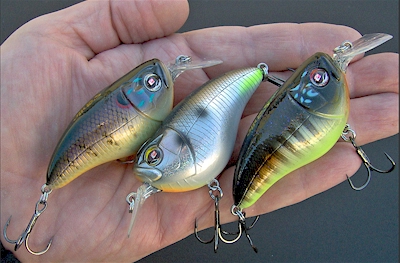
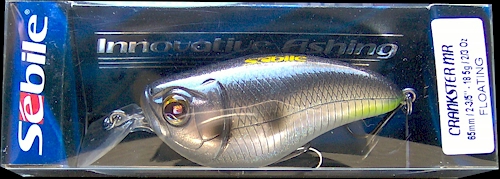
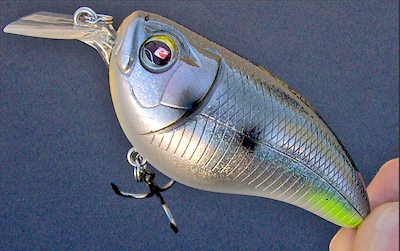
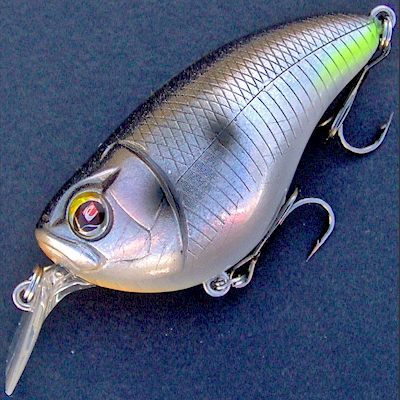
Sebile Crankster 65 MR ~ Medium Runner ~ Nat. Fleeing Shad
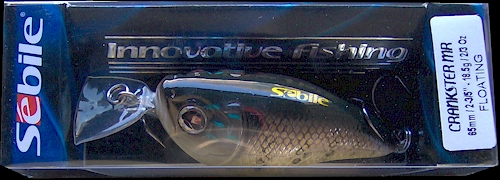
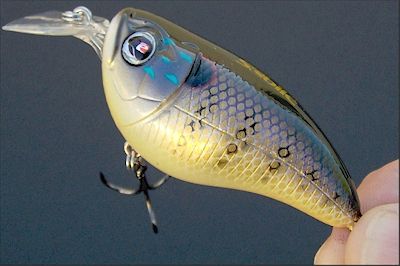
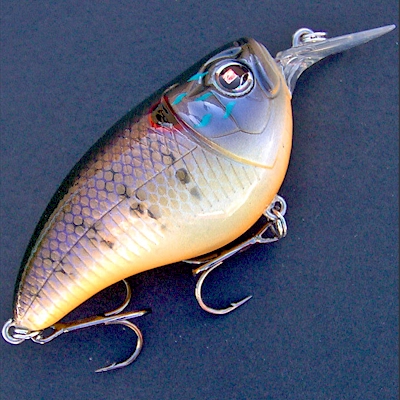
Sebile Crankster 65 MR ~ Medium Runner ~ Nat. Bluegill
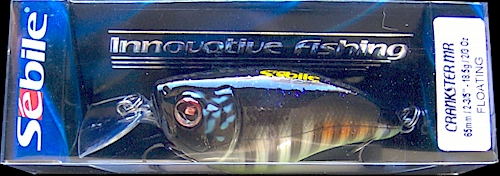

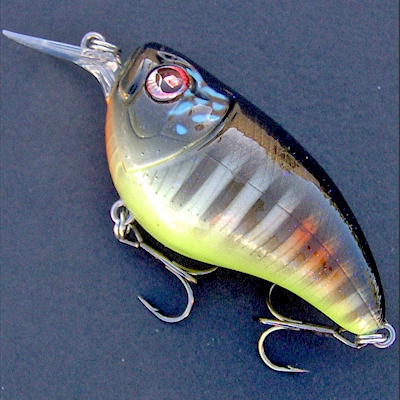
Sebile Crankster 65 MR ~ Medium Runner ~ Nat. Tilapia Yellow
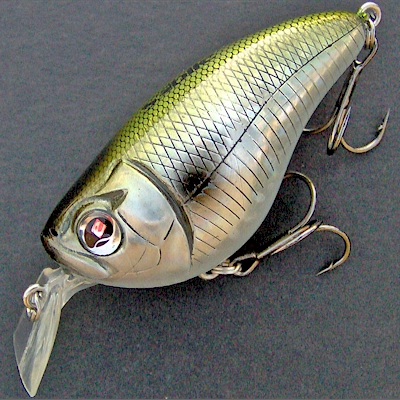

Sebile Crankster 65 MR ~ Medium Diver ~ Holo Greenie
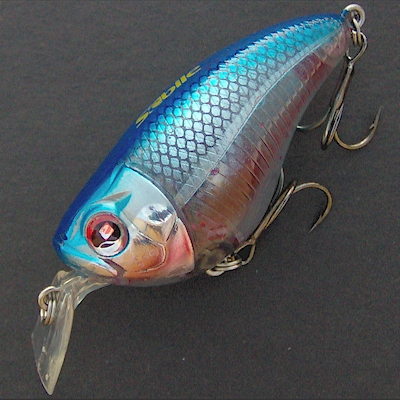
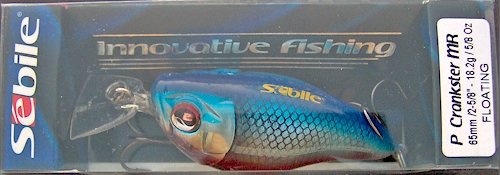
Sebile Crankster 65 MR ~ Medium Diver ~ Blood Red Blue
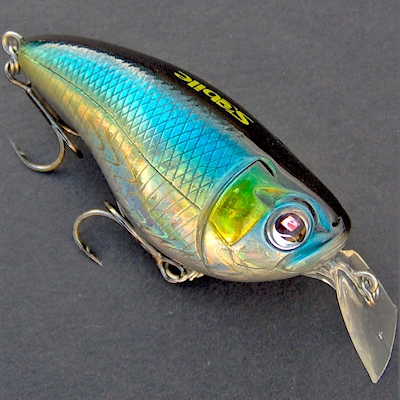
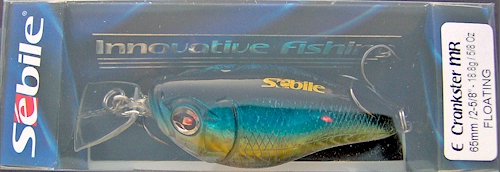
Sebile Crankster 65 MR ~ Medium Diver ~ Blue Althea
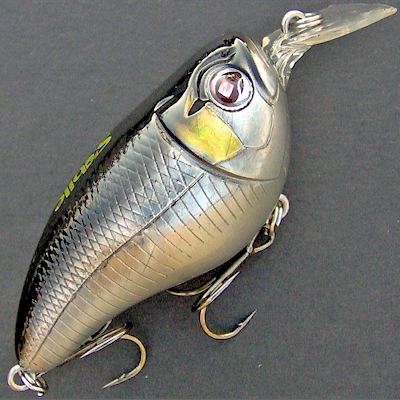
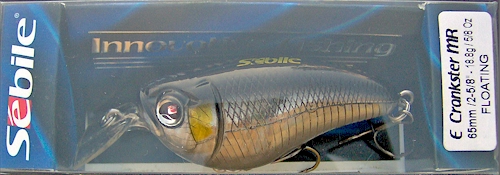
Sebile Crankster 65 MR ~ Medium Diver ~ Natural Shiner
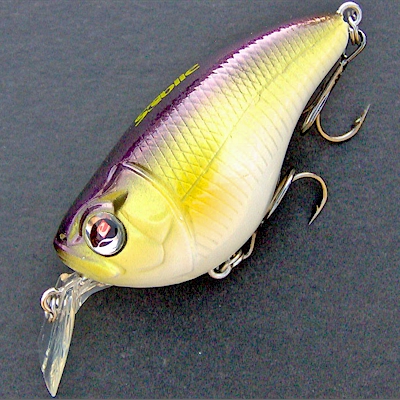
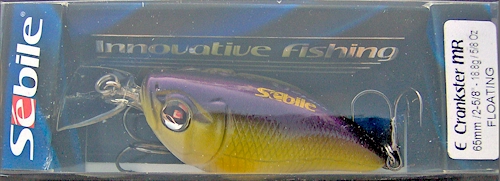
Sebile Crankster 65 MR ~ Medium Diver ~ Ghost Violet
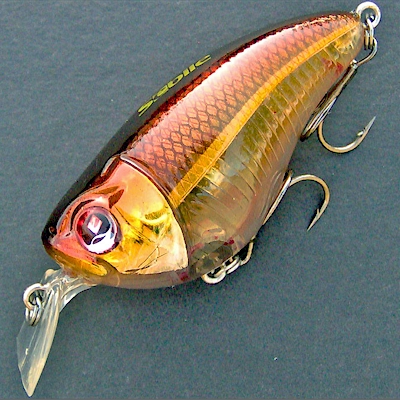
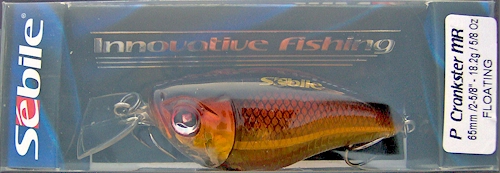
Sebile Crankster 65 MR ~ Medium Diver ~ Blood Red Amber
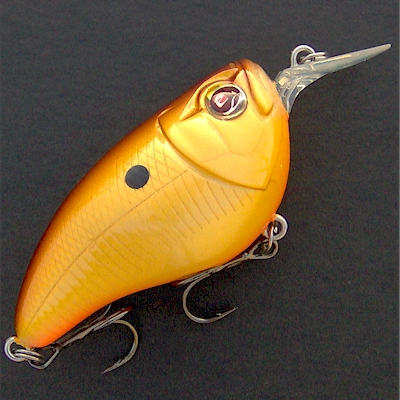
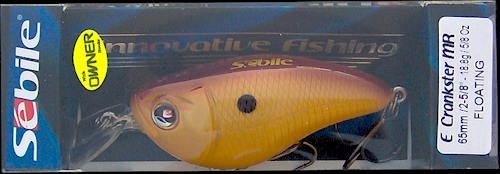
Sebile Crankster 65 MR ~ Deep Bronze
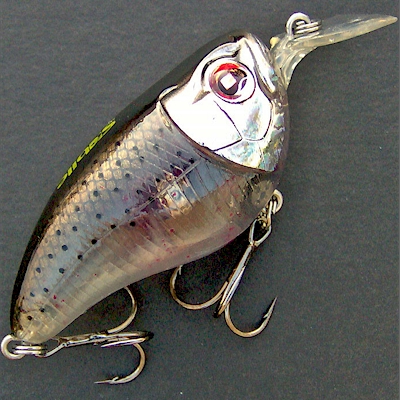
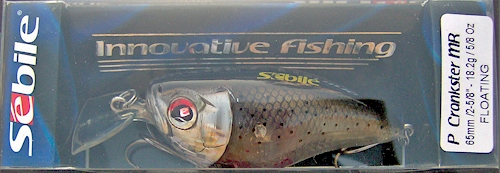
Sebile Crankster 65 MR ~ Medium Diver ~ Blood Red Dark
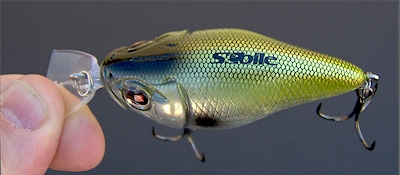
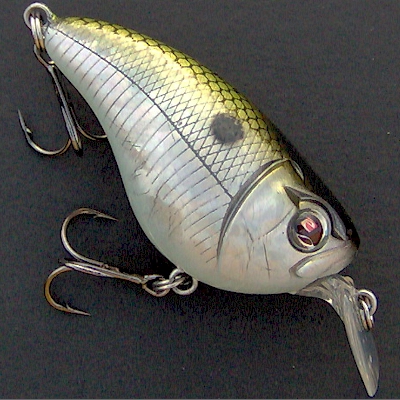

Sebile Crankster 55 MR ~ Medium Diver ~ Holo Greenie
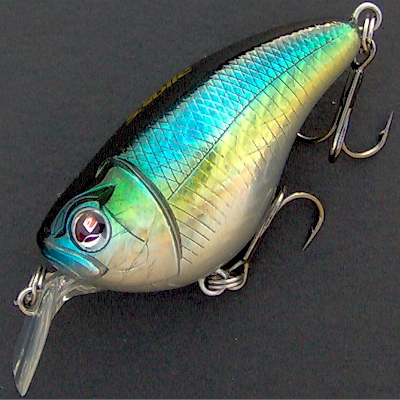

Sebile Crankster 55 MR ~ Medium Diver ~ Blue Althea
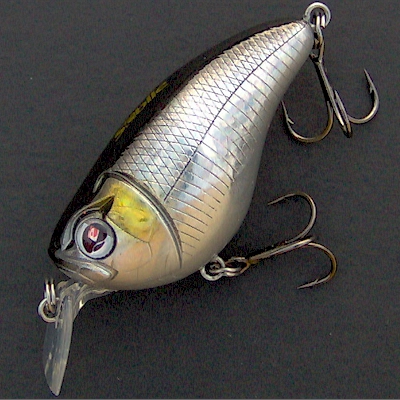

Sebile Crankster 55 MR ~ Medium Diver ~ Natural Shiner
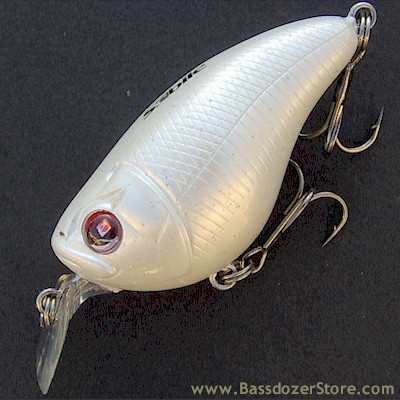

Sebile Crankster 55 MR ~ Medium Diver ~ White Lady
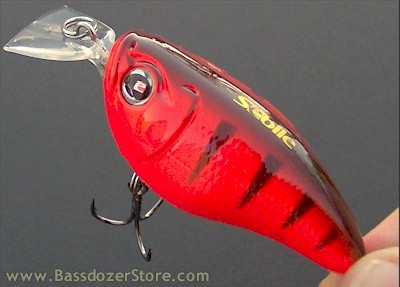
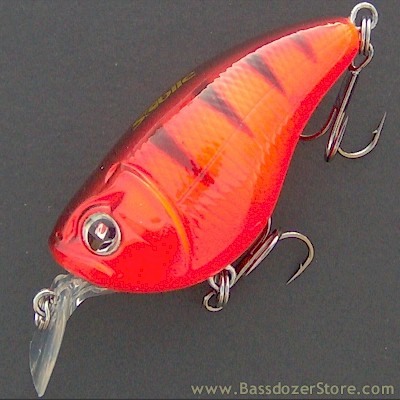

Sebile Crankster 55 MR ~ Medium Running Crankbait ~ Craw Perch
Rattslers are flat-sided and have thin bodies - but comparatively big side profiles. The big sides stir and move a lot of water, creating tons of turbulence as the Rattslers wiggle along. The swimming movement can be called tight and frantic, and there is a lot of side-to-side full body flipping motion.
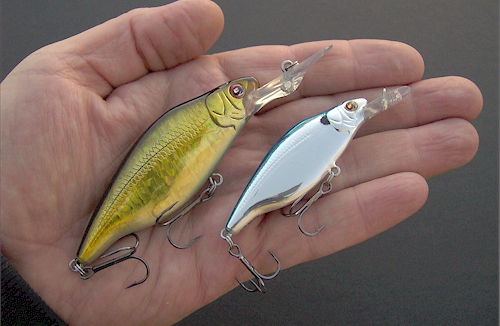
There are two different size Rattslers - 85 (left) and 65
(right).
Both 85 and 65 sizes come in SL (short lip), ML (medium lip) and VLL (very long lip) versions - six models in all.
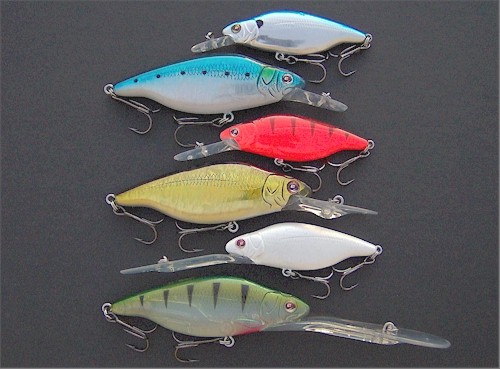
From top down: 65 SL, 85 SL, 65 ML, 85 ML, 65 VLL, 85 VLL.
| Model | Size | Weight | Running Depth |
Type |
| Rattsler 65 SL | 2-3/5" (65mm) | 1/4 oz (6.2g) | 6 to 10 inches | Short lip. Subsurface swimmer. Tight side-to-side flipping motion, rattling |
| Rattsler 65 ML | 2-3/5" (65mm) | 1/4 oz (7.2g) | 1 to 2 feet | Medium lip. Shallow Diver/Fast Riser. Tight side-to-side flipping motion, rattling |
| Rattsler 65 VLL | 2-3/5" (65mm) | 1/3 oz (8.2g) | 8 to 15 feet | Vey long lip. Deep Diver/Fast Riser. Tight side-to-side flipping motion, rattling. |
| Rattsler 85 SL | 3-1/3" (85mm) | 1/2 oz (12.5g) | 10 to 18 inches | Short lip. Subsurface swimmer. Tight side-to-side flipping motion, rattling. |
| Rattsler 85 ML | 3-1/3" (85mm) | 1/2 oz (14g) | 2 to 4 feet | Medium Lip. Shallow Diver/Slow Riser. Tight side-to-side flipping motion, rattling. |
| Rattsler 85 VLL | 3-1/3" (85mm) | 5/8 oz (17.5g) | 10 to 20 feet | Very Long Lip. Super Deep Diver/Slow Riser. Tight side-to-side flipping motion, rattling. |
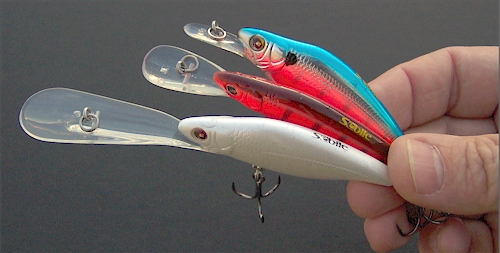
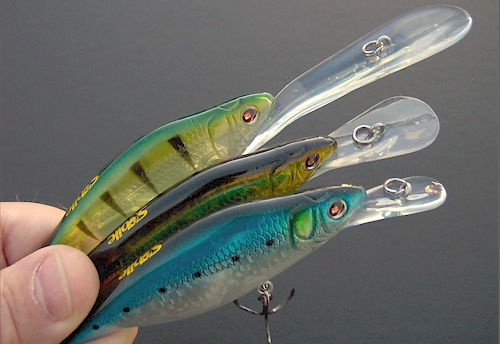
From top down. First photo: Rattler 65 SL, ML, VLL. Second:
Rattler 85 VLL, ML, SL.
About the two sizes:
| Model | Size | Weight | Running Depth |
Type |
| Rattsler 65 ML | 2-3/5" (65mm) | 1/4 oz (7.2g) | 1 to 2 feet | Medium lip. Shallow Diver/Fast Riser. Tight side-to-side flipping motion, rattling |
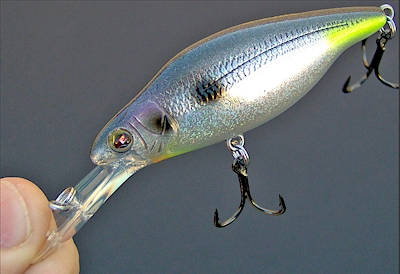
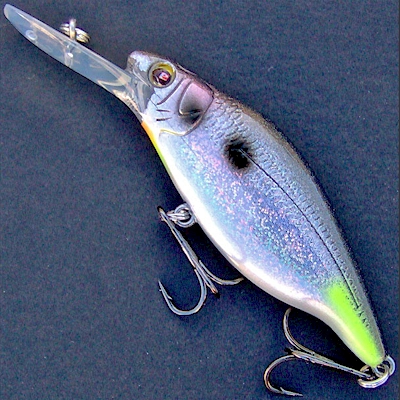

Sebile Rattsler 65 ML ~ Shallow Runner ~ Nat. Fleeing Shad
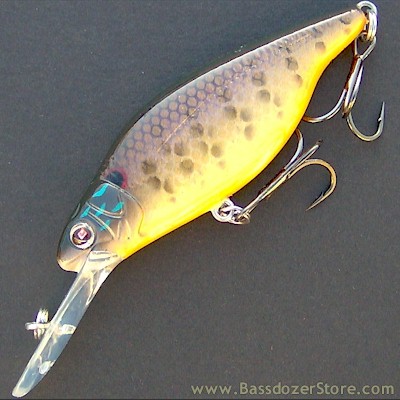

Sebile Rattsler 65 ML ~ Shallow Runner ~ Nat. Bluegill
| Model | Size | Weight | Running Depth |
Type |
| Rattsler 65 VLL | 2-3/5" (65mm) | 1/3 oz (8.2g) | 8 to 13 feet | Vey long lip. Deep Diver/Fast Riser. Tight side-to-side flipping motion, rattling. |
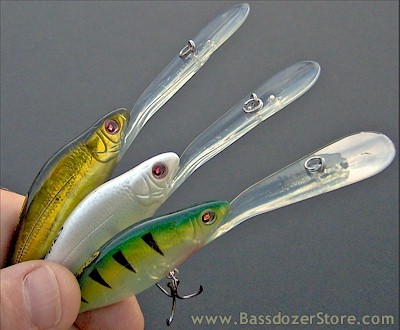
Sebile Rattsler 65 VLL trio show off their Very Long Lips.
The smaller Rattsler 65 VLL is a great choice around the outside edges of grass beds which tend to grow to depths of 10-13 feet. What to do is to cast the 65 VLL along the outside edges of the grass, in about the 10 to 13 foot range. Since it's smaller, you can burn and rip the 65 VLL through the grass rapidly to provoke an instinctive reaction strike. Usually try to make bottom contact if possible or just barely tick the outside edge of the grass. What you want to do is crank it down until you bump the bottom or cover and if it's grass, just kind of jerk it out of that grass and get that reaction strike as it breaks free from the weeds.
It's also good for coming through any type of submerged cover - tree tops, brush beds or what have you in the 10-13 foot depth range. Since they're smaller and thinner, the 65 VLLs can wiggle their way through a lot of cover that would stop bulkier lures with bigger hooks. When it does get hung in wood or brush, you can't really rip it out like in grass. However, the 65 VLL is a fast-riser so it will float up quickly when paused. Allow it to pause, and it will often back out of and rise up over whatever wood or brush had been impeding its forward progress.
Also, since they're relatively smaller crankbaits, the 65 VLL's are ideally suited for deep cranking situations on small ponds and small streams or where mainly small bass are found. The 65s are suited to clearer water, smaller waters or finesse situations with light tackle. But don't think light tackle is the only way to use them. Despite the lure's compact size, it is a good caster on mid-range (say 10 lb test) cranking rod, and the hooks are small (to avoid snagging) but strong. Sebile pro staffer Stephen Johnston from Texas uses the 65 VLL often in the manner described above to lure big Texas bass along the edges of thick hydrilla. So although it looks small, the 65 VLL and the hooks it has can handle big bass in thick grass.
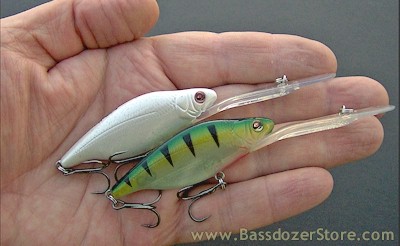
You've got to hand it to the Sebile Rattsler 65 VLL deep diving
duo shown above.
The 65 VLL may look small, but it casts good. The way this bait is designed, the weight goes to the tail end of the bait when you throw it. So it casts far and true, it does not have a barrel roll effect or a spin. You can make good long casts and with the long lip, the 65 VLL gets down around 10 to 13 feet deep, using 10 pound fluorocarbon line.
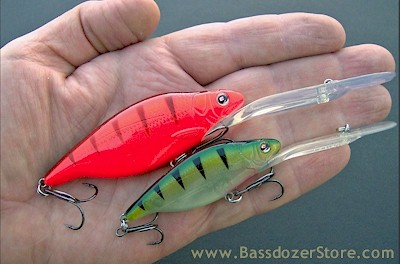
Handy comparison of Sebile Rattsler 85 VLL (top) and 65 VLL
(bottom).
The difference between the two sizes is that, you can fish the 65 VLL rapidly in and around deep cover. On the other hand, the 85 VLL gets down deeper, is a comparatively slow-riser when paused, and is a great bottom-bouncing crank in deep water. If the fish want it, you can take it slower and crank the 85 VLL very slowly. The 85 VLL will bog down in weeds more deeply, so it's harder to rip it out - but there are days when fish want that. Compare that information to what was discussed above for the 65 VLL, and you can see that although the 85 VLL and 65 VLL look similar, there are key differences in how best to use them.
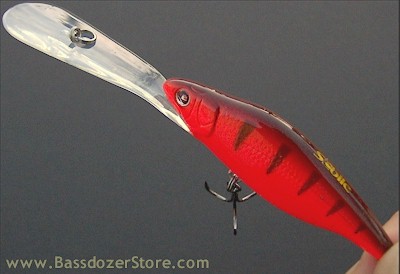
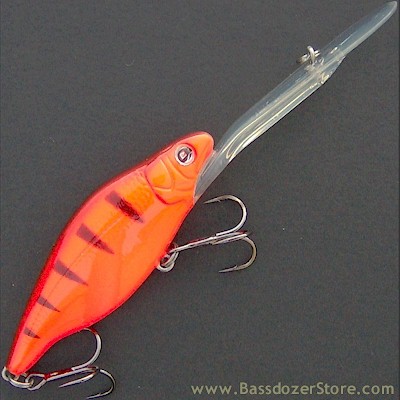

Sebile Rattsler 65 VLL ~ Deep Diving Crankbait ~ Craw Perch
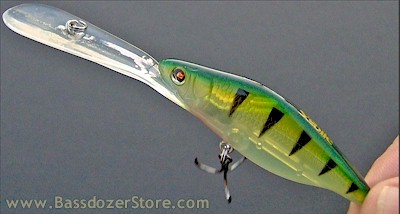
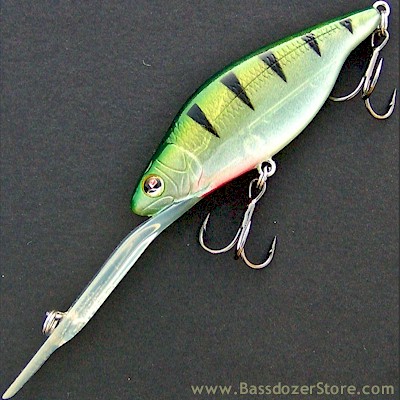

Sebile Rattsler 65 VLL ~ Deep Diving Crankbait ~ Natural Perch
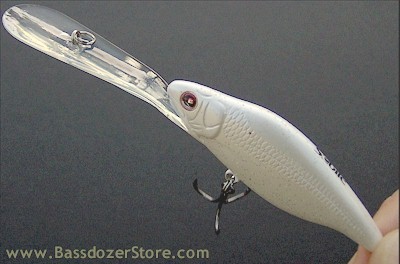
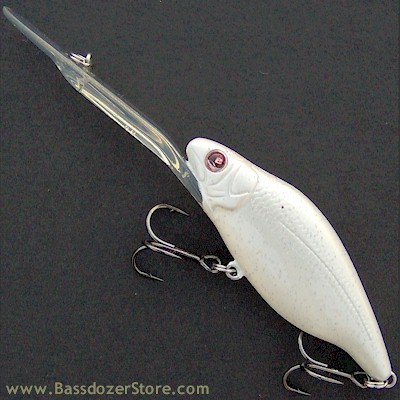

Sebile Rattsler 65 VLL ~ Deep Diving Crankbait ~ White Lady
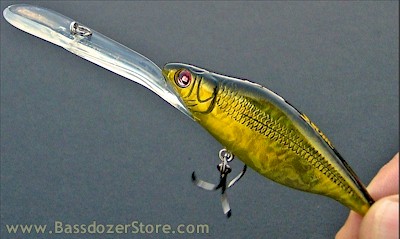
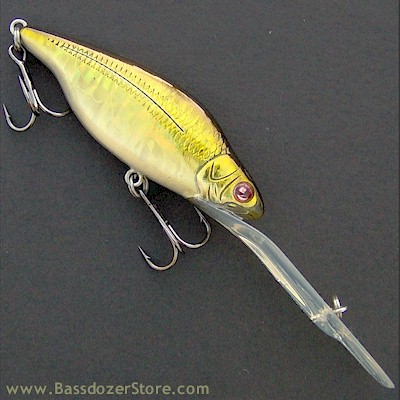

Sebile Rattsler 65 VLL ~ Deep Diving Crankbait ~ Natural Gold
Shiner
| Model | Size | Weight | Running Depth |
Type |
| Rattsler 85 ML | 3-1/3" (85mm) | 1/2 oz (14g) | 2 to 4 feet | Medium Lip. Shallow Diver/Slow Riser. Tight side-to-side flipping motion, rattling. |

The 85 ML (top) dives 2-4 feet deep. The 85 VLL (bottom) dives
10-20 feet down. Both rattle loudly.
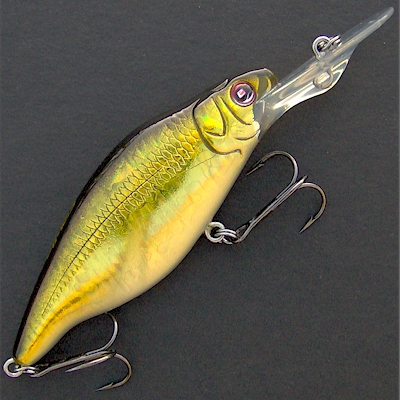

Sebile Rattsler 85 ML ~ Shallow Diver ~ Natural Golden Shiner
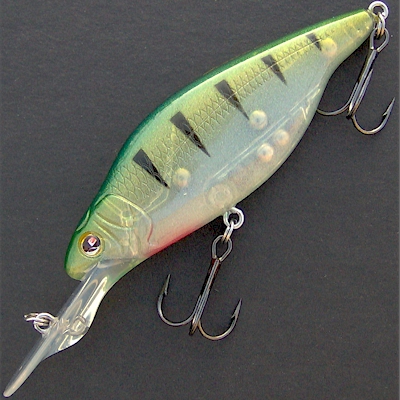

Sebile Rattsler 85 ML ~ Shallow Diver ~ Natural Perch
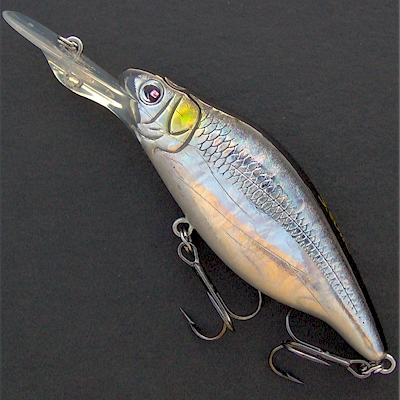

Sebile Rattsler 85 ML ~ Shallow Diver ~ Natural Shiner
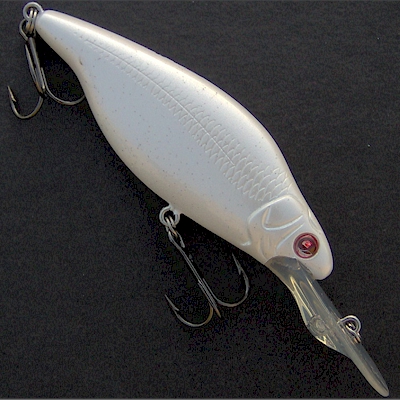

Sebile Rattsler 85 ML ~ Shallow Diver ~ White Lady
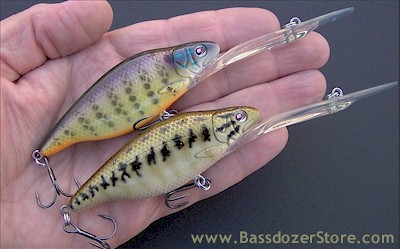
| Model | Length | Weight | Depth | Type |
| Rattsler 85 VLL | 3-1/3" (85mm) | 5/8 oz (8g) | 10-20' | Very Long Lip. Super Deep Diver/Slow Riser. Tight side-to-side flipping motion, rattling. |
"They throw a lot of deep-diving crankbaits where I'm from, down in Texas," says SEBILE pro-staffer Stephen Johnston, "and the Rattsler 85 VLL is my favorite deepwater crank, particularly in summer and early fall, when you've got to keep a crankbait down deeper. I can get the VLL 85 to bump the bottom in about 16-17 feet of water, using a cranking rod with ten pound fluorocarbon line."
The 85 VLL is a slow-floater or slow-riser, so once it gets down, it doesn't rise so quickly when paused. That makes it good for a little lingering pause or hesitation in the action on relatively open bottom structure - ledges, humps, points, etc. Some days, the fish may want the 85 VLL right along deep grass edges or coming past deep flooded brush, but you have to take it slower and crank it slowly or else the 85 VLL will bog down in weeds or wood - but there are days when fish want it that way, so you just have to finesse the retrieve to make it work.
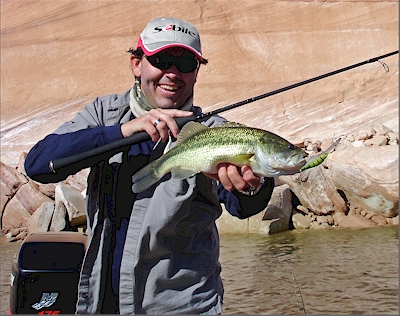
Pat Sebile lands one that was 15-20' deep on Lake Powell on
Rattsler 85 VLL.
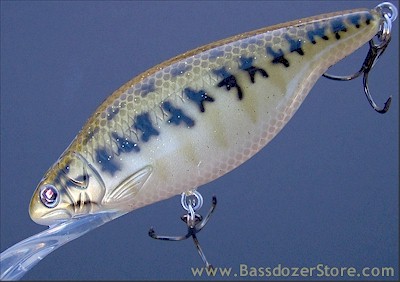
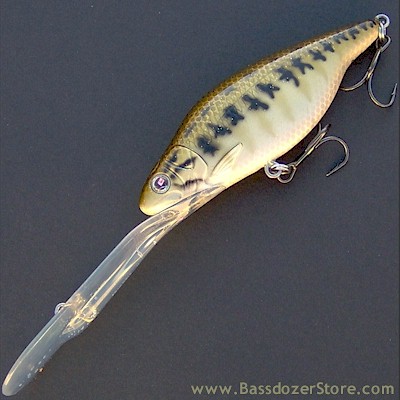

Sebile Rattsler 85 VLL ~ Super Deep Crankbait ~ Natural
Largemouth Bass



Sebile Rattsler 85 VLL ~ Super Deep Crankbait ~ Natural Bluegill

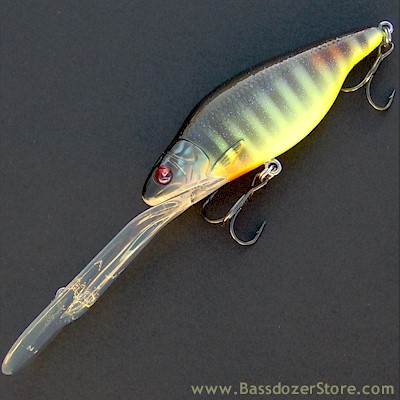

Sebile Rattsler 85 VLL ~ Super Deep Crankbait ~ Natural Tilapia
Yellow
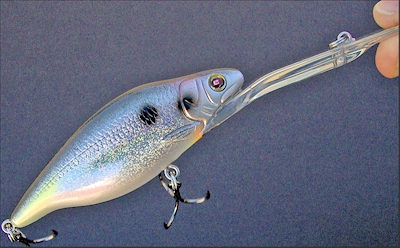
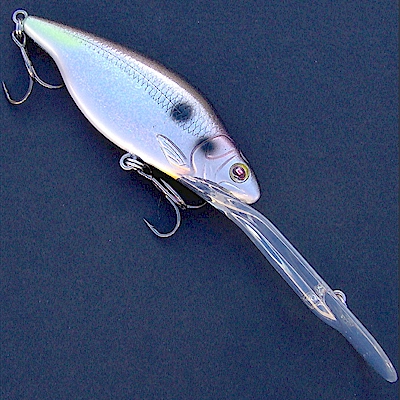

Sebile Rattsler 85 VLL ~ Super Deep Crankbait ~ Nat. Fleeing Shad
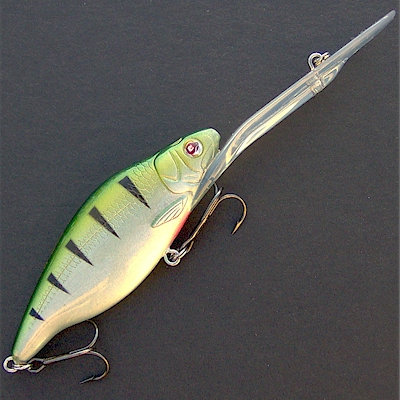

Sebile Rattsler 85 VLL ~ Crankbait ~ Natural Perch
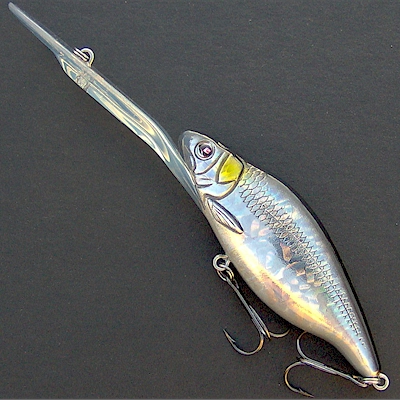

Sebile Rattsler 85 VLL ~ Crankbait ~ Natural Shiner


Sebile Rattsler 85 VLL ~ Crankbait ~ White Lady
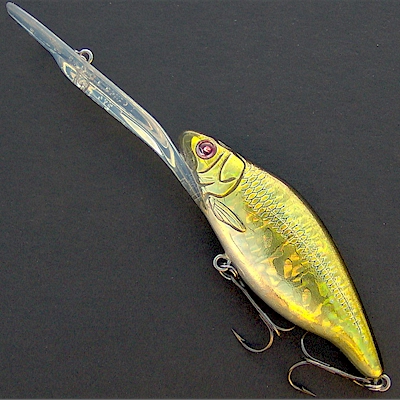

Sebile Rattsler 85 VLL ~ Crankbait ~ Natural Golden Shiner
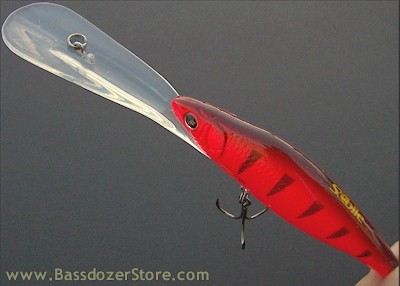
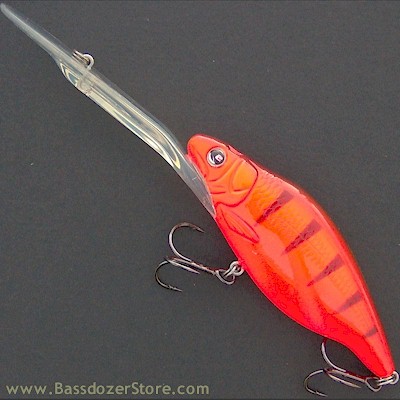

Sebile Rattsler 85 VLL ~ Deep Diving Crankbait ~ Craw Perch
The bonga minnow is a member of the herring and shad family commonly found in the estuaries and along the west coast of Africa.
It's also a superb new topwater lure found in Sebile's product line. It comes in three sizes.

| Model | Type | Length | Weight |
| Bonga Minnow 72 | Topwater | 2.8" (72mm) | 3/8 oz (10g) |
| Bonga Minnow 95 | Topwater | 3.7" (95mm) | 3/4 oz (21g) |
| Bonga Minnow 125 | Topwater | 5" (125mm) | 2 oz (55g) |
The Bonga Minnow is already very popular for inshore saltwater fishing especially in Texas, Florida and throughout the Gulf of Mexico for redfish, sea trout, snook, tarpon and others. So Sebile does not need to grow sales of the Bonga Minnow right now. It's already one of their best-sellers for saltwater. Therefore, the company has not done much to promote the Bonga Minnow for freshwater fishing yet.
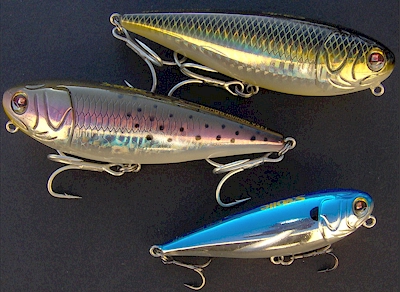
The Bonga Minnow 95 (top 2) and Bonga Minnow 72 (bottom) are some
of Sebile's most successful models in saltwater.
But that doesn't mean you shouldn't use Bonga Minnows in freshwater too. They really are very effective for bass Ė largemouth, smallmouth and spotted.
The only thing that makes a Sebile lure freshwater or saltwater are the hooks. Otherwise, everything about the lures are exactly the same. There is no other difference between a freshwater or saltwater model except the hooks.
Some Bonga Minnows and other Sebile baits have saltwater finish hooks, and anglers often ask if these tin-colored hooks can be used for bass? Yes, they are fine hooks for freshwater also. They're strong, super sharp and you should not notice any difference in hooking and holding fish. The Sebile saltwater hooks are some of the best hooks for freshwater usage.
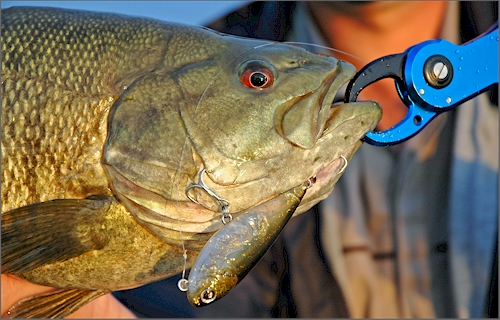
Smallmouth and Bonga Minnow 72 with tin-colored saltwater hooks.
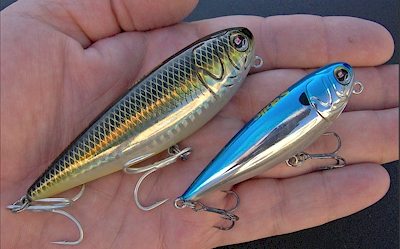
Size comparison of Bonga Minnow 95 and 72.
When at rest in the water, the line tie eye sits barely below water, with just the eyes and an inch (72 model) to1-3/4 inches (95 model) of the top of the head out of the water. The tail points down at approximately a 35 degree angle.
The Bonga Minnow 72 measures under 3 inches and weighs 3/8 ounce.
| Model | Type | Length | Weight |
| Bonga Minnow 72 | Topwater | 2.8" (72mm) | 3/8 oz (10g) |
It's rippling, waking action is more silent than splashy. It has a slow-moving side-to-side action that disturbs a lot of water but is very quiet.
It is also very versatile and useful in diverse situations and under different conditions:
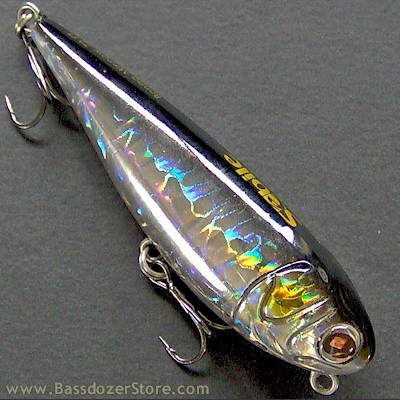

Sebile Bonga Minnow 72 ~ Topwater ~ Natural Shiner
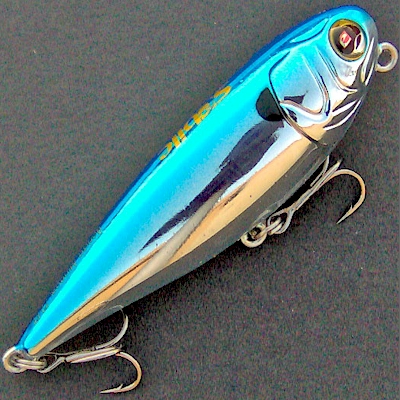

Sebile Bonga Minnow 72 ~ Topwater ~ Blue Chrome
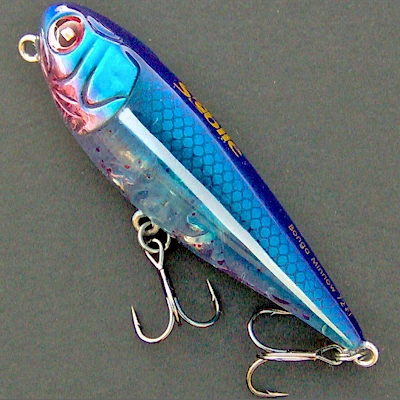

Sebile Bonga Minnow 72 ~ Topwater ~ Blood Red Blue
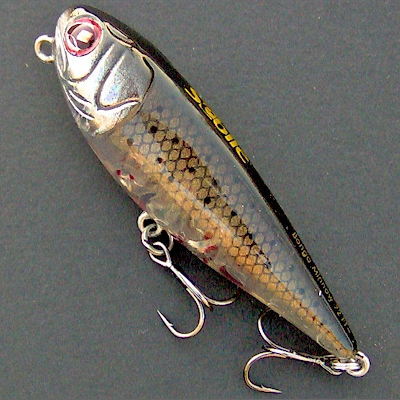

Sebile Bonga Minnow 72 ~ Topwater ~ Blood Red Dark
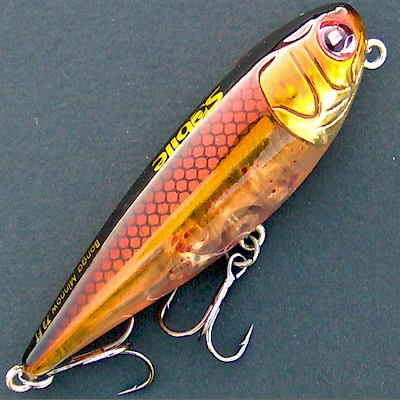

Sebile Bonga Minnow 72 ~ Topwater ~ Blood Red Amber
The Bonga Minnow 95 measures 3-3/4 inches and weighs 3/4 ounce.
| Model | Type | Length | Weight |
| Bonga Minnow 95 | Topwater | 3.7" (95mm) | 3/4 oz (21g) |
If there is some wind, the bulky body of the Bonga Minnow 95 helps you keep slack out of your line as you work it.
The short but chunky Bonga Minnow 95 moves a lot of water to make it very noticeable from afar. It has a walk-the-dog action. The wake and disturbance makes it seem to be a bigger prey Ė and it's a very effective bait for bass.
Note that the Bonga Minnow 95 comes with saltwater hooks that are also perfect for freshwater bass, especially a little bigger size of bass on a little heavier that usual topwater tackle. If you are fishing in an area or with tackle more suited to average size bass, you may replace the saltwater hooks with same size freshwater hooks. For example, in the photo below, the stock tin-colored hooks (bottom) have been switched out for Mustad #36102 BLN #2 trebles. The Mustad 36102 is still a very strong #2 hook, yet a little easier to set on average size bass with average strength topwater tackle.
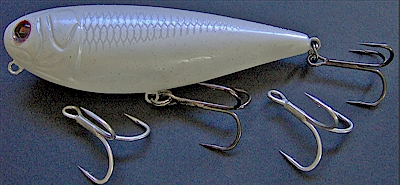
Stock tin hooks (bottom) may optionally be replaced with
freshwater #2 hooks. In this case, Mustad #36102BLNs (not
included).
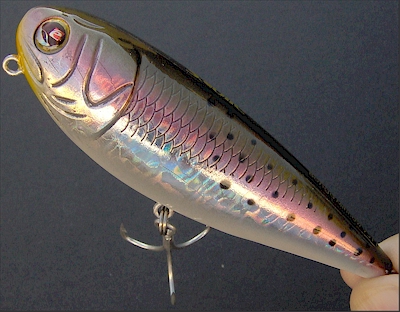
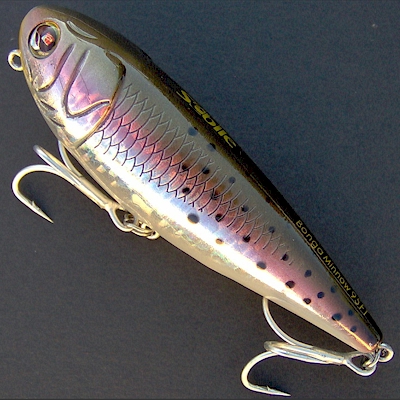

Sebile Bonga Minnow 95 ~ Topwater ~ Natural Sea Trout
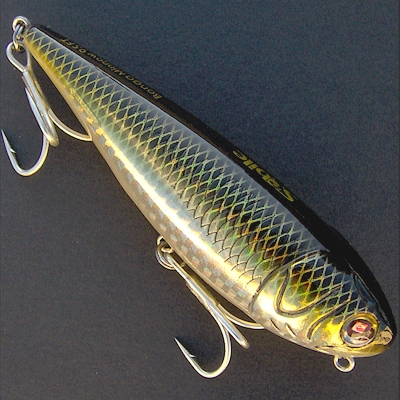
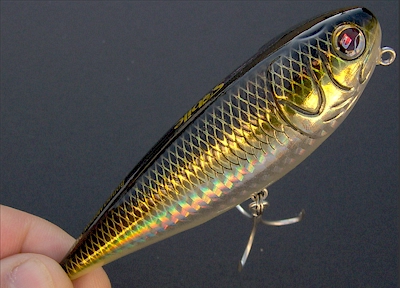

Sebile Bonga Minnow 95 ~ Topwater ~ Natural Mullet
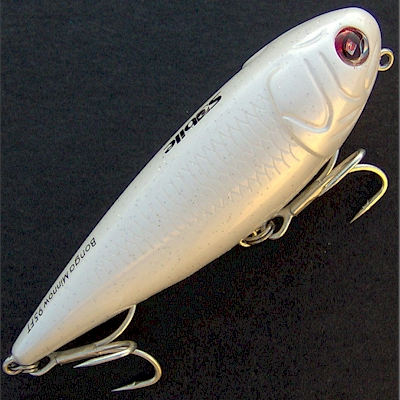

Sebile Bonga Minnow 95 ~ Topwater ~ White Lady
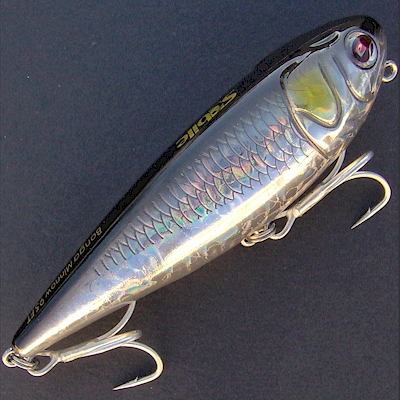
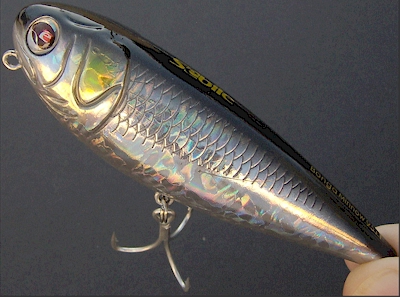

Sebile Bonga Minnow 95 ~ Topwater ~ Natural Shiner
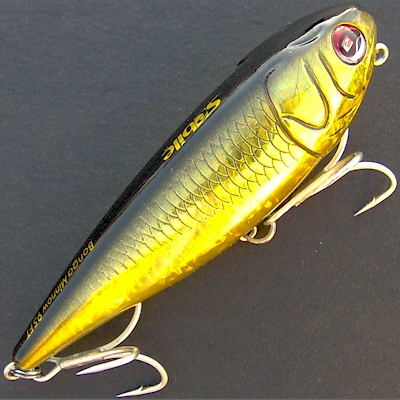

Sebile Bonga Minnow 95 ~ Topwater ~ Natural Gold Shiner
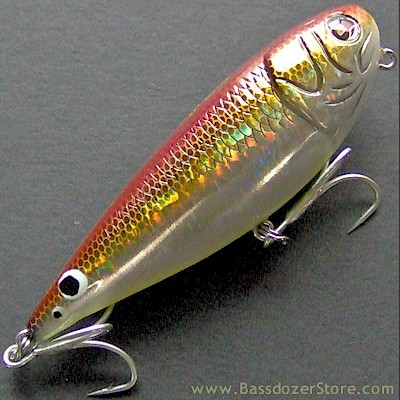

Sebile Bonga Minnow 95 ~ Topwater ~ Natural Red Drum
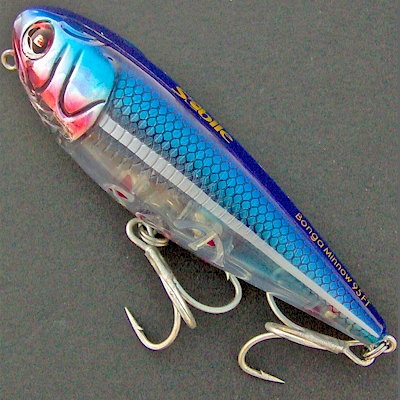

Sebile Bonga Minnow 95 ~ Topwater ~ Blood Red Blue
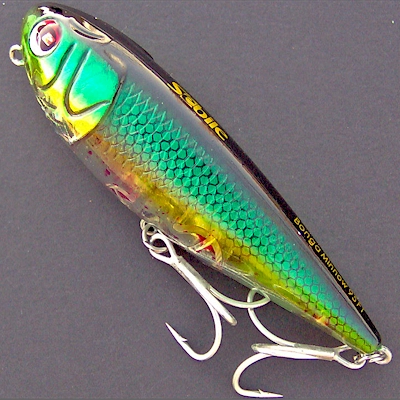

Sebile Bonga Minnow 95 ~ Topwater ~ Blood Red Green
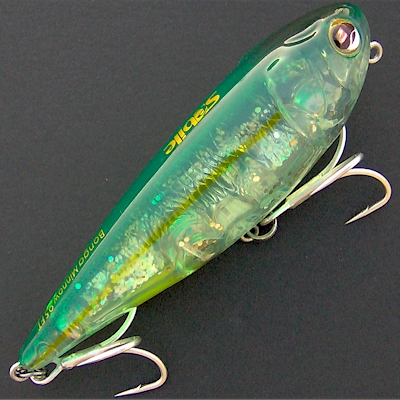

Sebile Bonga Minnow 95 ~ Topwater ~ Natural Green Back
Just to give a little secret away, the big Bonga Minnow 125 is one of Sebile's very best baits to target trophy largemouth bass.
The Bonga Minnow 125 is 5 inches long with a bulky girth, weighing a hefty 2 ounces.
| Model | Type | Length | Weight |
| Bonga Minnow 125 | Topwater | 5" (125mm) | 2 oz (55g) |
It's through-wired so the hook hangers and line tie are formed from a single piece of wire running from head to tail along its belly.
Only the very smallest of rod movements are needed to work it. It is very efficient, really doesnít tire you like some others big topwaters, is easy to cast and its shape is easily engulfed by bass, so few fish are lost.
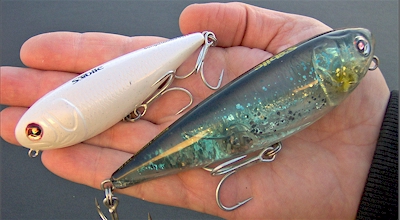
Bonga Minnow 95 (left) for numbers and Bonga Minnow 125 (right)
for trophies. Topwater doesn't get any better than this!
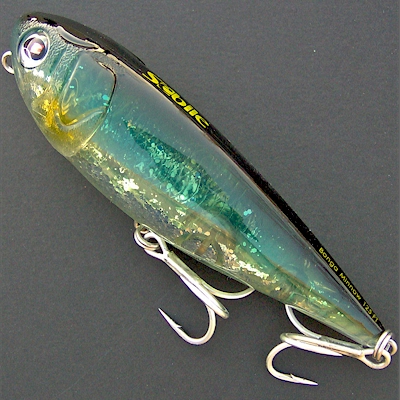

Sebile Bonga Minnow 125 ~ Topwater ~ Natural Dark Blue Back
The slender yet sturdy and distinctly curved Slim Stick topwater walking lure comes in three sizes to cover every situation. All three sizes walk the dog with ease and precision. It just depends how big of a fish you desire to catch!
| Model | Length | Weight | Depth | Type |
| Slim Stick 98 | 3-7/8" (98mm) | 3/8 oz (10.6g) | Surface | Topwater, Walking |
| Slim Stick 118 | 4-5/8" (118mm) | 5/8 oz (17.2g) | Surface | Topwater, Walking |
| Slim Stick 138 | 5-1/2" (138mm) | 1 oz (26.6g) | Surface | Topwater, Walking |
The Slim Stick is topwater walking bait, meaning it "walks the dog" side to side, first right, then left, each time you work the rod tip.
Most of the body stays underwater while it walks. Only the head and eyes are out of the water. Part of the overall action is it has a little head bob or head bounce each time you work it.
It's pretty precise and consistent. You can say it executes perfect X's the way it walks from side to side. First one half of the X, then the other half, over and over, each time you jerk it.
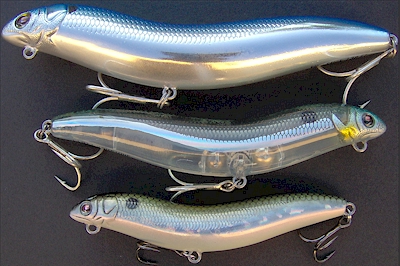
The 3/8 oz 98 (bottom) is the size suited for most conditions.
The 5/8 oz 118 (center) is a little bigger to attract a little
better size of fish. The 1 oz 138 (top) is a big bait to appeal
to big bass.
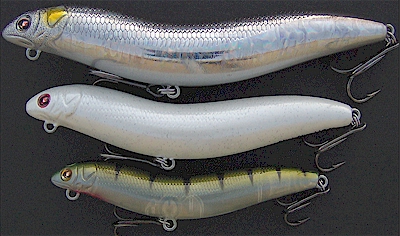
The 118 (center) and especially the 98 (bottom) are the most
popular sizes for bass. The 138 (top) is pretty big. It's ideal
for trophy bass. The 118 and 98 are for small to medium bass.
The creased belly keel of the Slim Stick 118 allows it to chine walk attractively when reeled or dragged across the surface for several feet.
| Model | Length | Weight | Depth | Type |
| Slim Stick 98 | 3-7/8" (98mm) | 3/8 oz (10.6g) | Surface | Topwater, Walking |
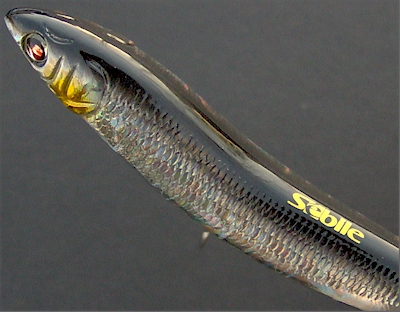
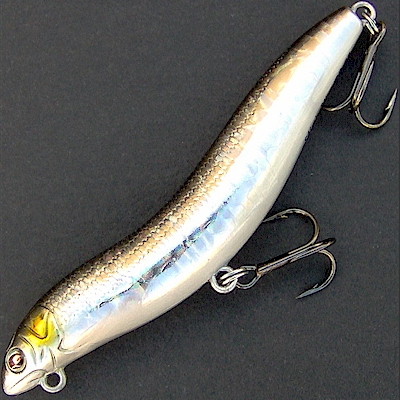

3/8 oz Sebile Slim Stick 98 ~ Topwater ~ Natural Shiner
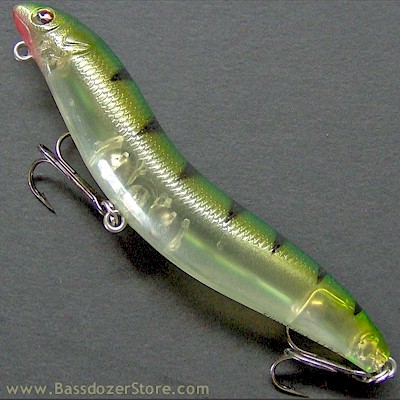

Sebile Slim Stick 98 ~ Topwater ~ Natural Perch
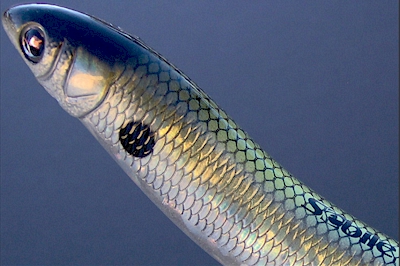
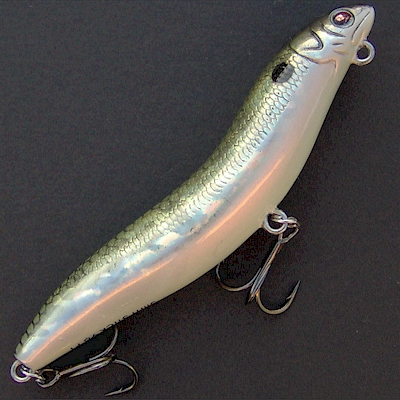

Sebile Slim Stick 98 ~ Topwater ~ Holo Greenie
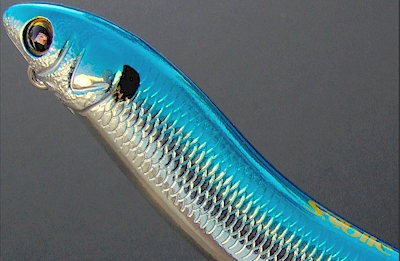
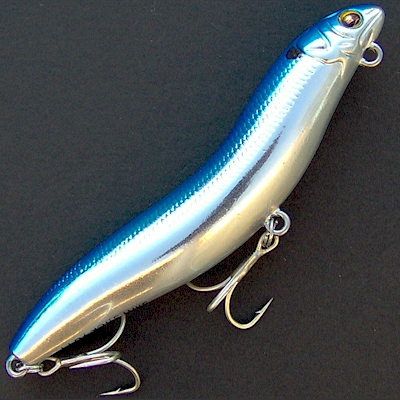

Sebile Slim Stick 98 ~ Topwater ~ Blue Chrome
| Model | Length | Weight | Depth | Type |
| Slim Stick 118 | 4-5/8" (118mm) | 5/8 oz (17.2g) | Surface | Topwater, Walking |
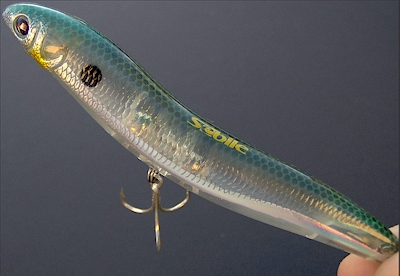
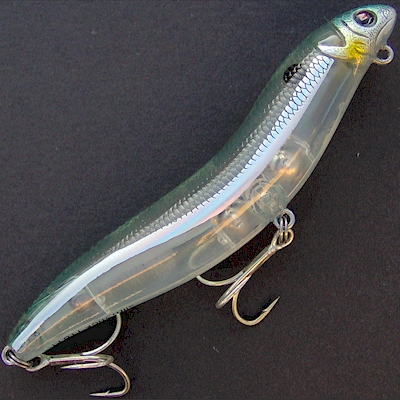
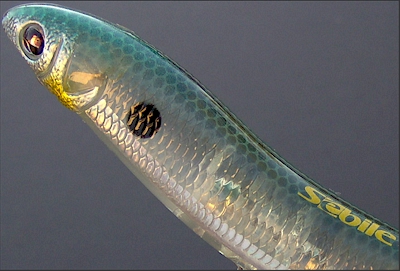

Sebile Slim Stick 118 ~ Topwater ~ Silver Liner
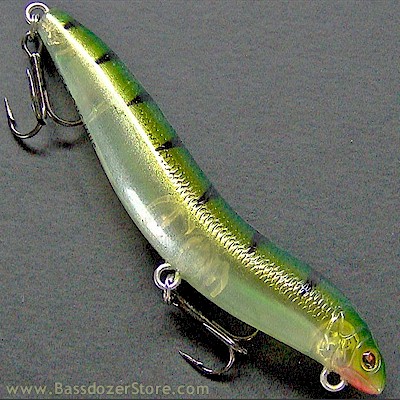

Sebile Slim Stick 118 ~ Topwater ~ Natural Perch
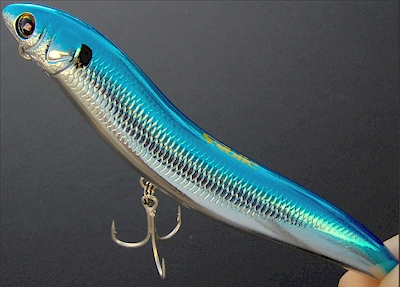
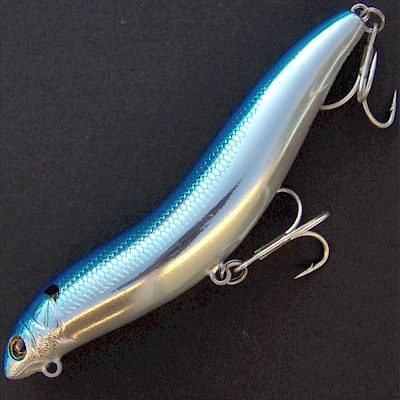

Sebile Slim Stick 118 ~ Topwater ~ Blue Chrome
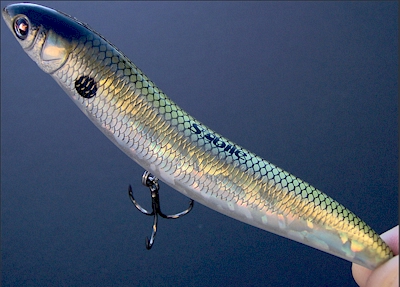
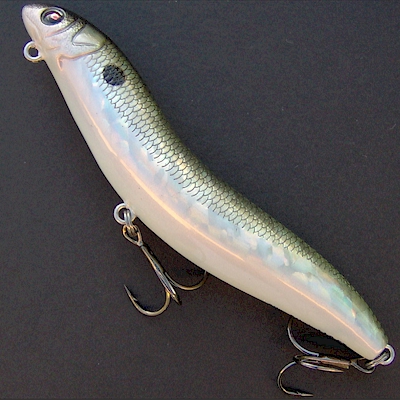

Sebile Slim Stick 118 ~ Topwater ~ Holo Greenie
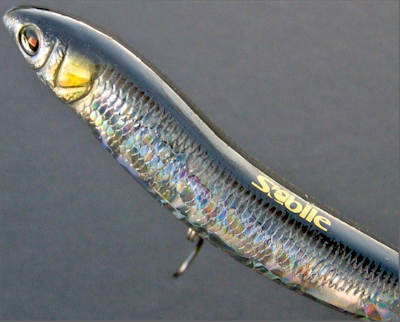
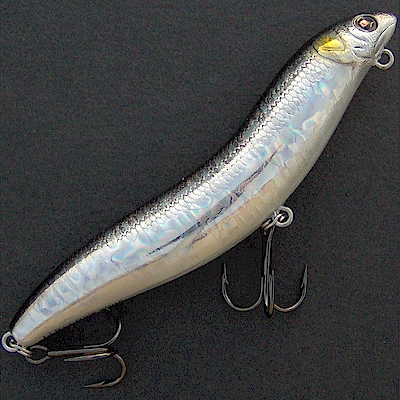

Sebile Slim Stick 118 ~ Topwater ~ Natural Shiner
| Model | Length | Weight | Depth | Type |
| Slim Stick 138 | 5-1/2" (138mm) | 1 oz (26.6g) | Surface | Topwater, Walking |
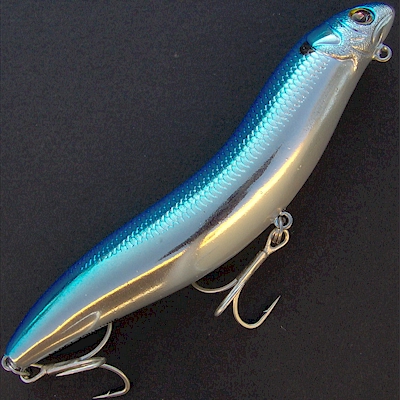

Sebile Slim Stick 138 ~ Topwater ~ Blue Chrome
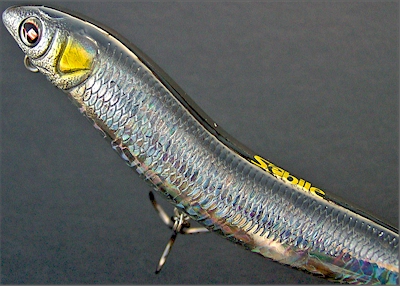
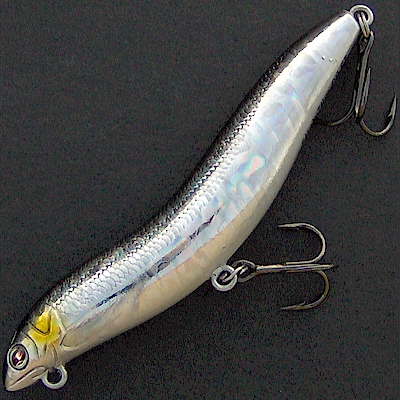

Sebile Slim Stick 138 ~ Topwater ~ Natural Shiner
| Model | Length | Weight | Depth | Type |
| Koolie Minnow 90 LL | 3-1/2" (90mm) | 3/8 oz (11g) | 8-20' | Long lip. Buoyant floater/diver. Tight, rolling action. Jerks responsively. Rises when paused. Avoids snags. |
Did you know? The Koolie Minnow 90 LL is SEBILE's top-selling lure in Japan. Ocean, surf and bay anglers in Japan favor it for catching sea bass, an inshore battler that is similar to the striped bass in the USA except in size, Japan's sea bass averages from 2 to 6 pounds. Fish of this size are a challenge on light saltwater tackle, and the Koolie 90 LL is a perfect match for this size fish and gear.
"On light to medium tackle, in saltwater or fresh, the Koolie 90 LL is always one of my favorite choices when I want to fish deep water, say from 8 to 10 feet casting (or deeper casting in a current) or as deep as 20 feet trolling," says Patrick Sebile.
"Especially in a tidal current or in a freshwater river, the Koolie 90 LL is as easy to use as simply casting it 90 degrees straight out, and let the current work the bait down and around, almost without reeling. Very simple, but oh so very effective!" exclaims an enthusiastic Patrick.
Laurent Picq, SEBILE's sales manager for Europe and Russia adds, "The Koolie Minnow family is also a top-seller in Europe, mainly for zander (Russia), pike (northern Europe and Russia), freshwater perch (across Europe) and European sea bass (Spain and Italy). It also is a good seller for the giant catfish called wels in Russia and Spain. Those cats can weigh up to 200 pounds, but the Koolie Minnow 90 LL is perfect for the plentiful and voracious 2 to 10 pound wels."
"The Koolie 90 LL is most popular in Russia more for trolling than casting, for all freshwater predators, pike, perch, zander and catfish," continues Laurent. "In France, where I am from, the most popular way of using it is casting with a steady retrieve just like an ordinary crankbait. French fishermen use it for pike, largemouth bass, European freshwater perch, sea bass and also zander, which is the European cousin of North America's walleye. My favorite way of using it for all these species is the steady retrieve method, sometimes using sudden, short pauses and/or twitches, but mainly steady reeling," instructs Laurent.
In North America, the Koolie Minnow is relatively new to anglers. Those who have tried it, have had good results with light to medium tackle for any small to medium size freshwater or saltwater fish that will hit a minnow, the Koolie 90 LL is perfect for casting to 10 feet deep and trolling down to 20 feet.
"What I like very much with the Koolie 90 LL is that this bait goes really deep for its size without pulling heavily on the rod tip as you retrieve it," says Patrick Sebile. "The easy retrieval of course gives a lot of comfort to the angler and less wrist and arm fatigue at the end of a long day, but more important than that is less water resistance, meaning less pulsation in the rod tip from the lure lip itself. Due to the articulated lip design, there is less feel of the lure, and that also increases the anglerís sensitivity to anything - a short strike, grass or debris on the hook, contact with bottom or cover - all are easier to detect since the lip resistance itself is not the overpowering sensation like with other long-billed hardbaits. So you can more easily detect short strikes, bottom, cover, debris and react quicker to whatever you feel making contact with the lure."
"Also, regular long-billed minnows do not cast very well because the long plastic bill extension of the lure's body is very air-resistant, so a regular long-billed bait doesn't cast very well. If there was no bill, a minnow would be aerodynamic and cast like a rocket. But that very long lip that causes water resistance to make it dive deeper, it also causes much air resistance to make it fall short when cast. I believe every angler may have experienced this distance-robbing effect already with regular long-billed baits. Not so with the Koolie 90 LL, thanks to the gap or space between the lureís nose and the lip, this helps the lure fly smoother in the air, with less air turbulence created around that part of the lure Ė which is the reason why the Koolie 90 LL sails so impressively smooth and far on a cast," smiles Patrick.
As anglers prefer to do in Europe, the Koolie Minnow may be retrieved steadily like a crankbait. It may also be trolled for multiple species as favored in Russia, or just allowed to strum and struggle down-current on a tight line which is a surefire tactic for sea bass success in Japan.
In North America, however, many anglers like to retrieve minnow baits with sharp jerks and frequent pauses. The Koolie Minnow excels when used this way as a jerkbait.
Many regular long-billed jerkbaits are suspending, meaning they will suspend and stay (or barely float or sink slowly) at the depth level they're at when the retrieve is paused. To the contrary, the Koolie 90 LL is a buoyant floater that will rise quickly when the retrieve is paused. This makes the Koolie 90 LL an excellent jerkbait to work through deep wood, brush or grass. When we say deep, we mean the Koolie 90 LL will reach approximately 8-10 feet when cast with 8-10 lb line. Whenever paused, however, it will immediately start to rise, and that lets it float up and out of wood, brush, grass or any other obstacles it may have encountered down there. A regular suspending jerkbait would sit and stay there, and has more chance to snag on obstacles since it can not rise quickly to free itself in order to continue moving forward like the Koolie Minnow can. As the Koolie 90 LL rises into the open above cover, it becomes more visible and vulnerable to attack, as its sudden emergence triggers predators to react quickly before the prey can dart back down into the relative safety of the cover again. That moment before you resume reeling again, is a high percentage strike point.
So why not give the Koolie 90 LL a try? It has a tight, rolling action, and dives deeper than most other minnow baits of the same size. It catches fish just like a crankbait when used with a steady retrieve. Also superb to use as a jerkbait with a cadence of jerks and pauses. Best of all, it can quickly float up and out of snags, making it a great choice to bring right through thick underwater cover where many other jerkbaits can't conveniently be used.
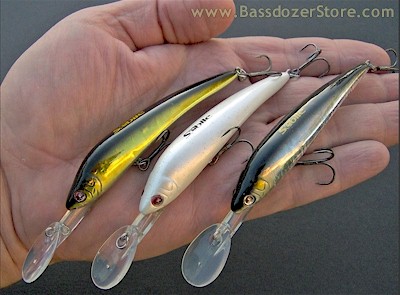
The long lip is distanced apart from the lure body, increasing
depth, ease of retrieval, casting distance, bite detection and
better feel for what the lure's coming in contact with.
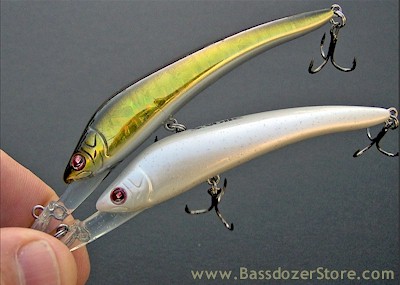
The highly buoyant body helps the Koolie 90 LL to float back up
out of and over snags that impede its forward progress.
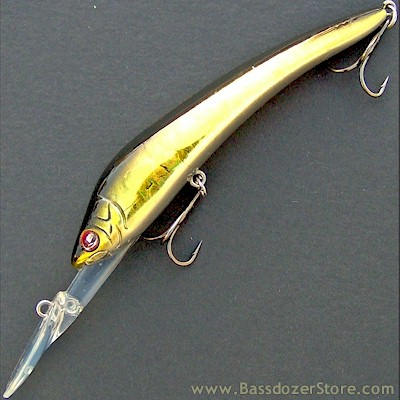
The long, extended lip contacts bottom. Meanwhile, the nose-down,
bottom-probing posture helps hold the hooks above snags.
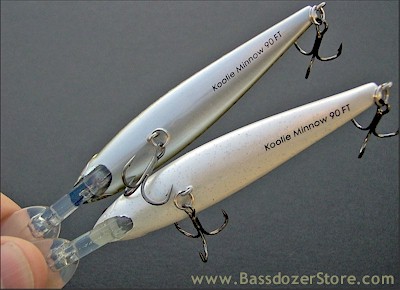
The wide, flat bottom helps the Koolie Minnow to push itself off
of and to roll itself over snags. The broad bottom serves as a
wide shield of protection to help hide the belly hook from snags.
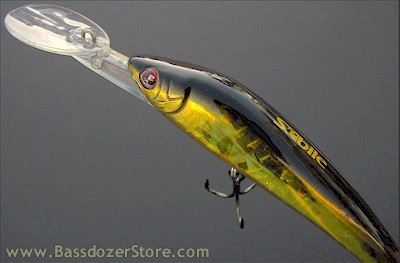


Sebile Koolie Minnow 90 LL ~ Deep Diving Jerkbait ~ Nat. Golden
Shiner
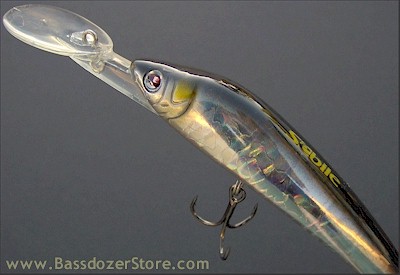
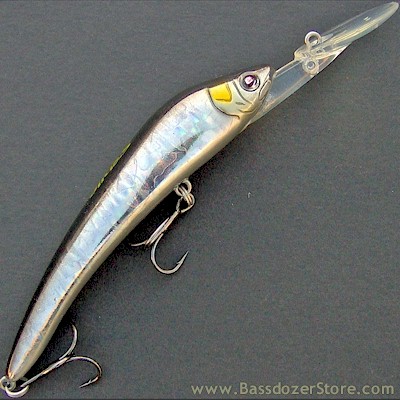

Sebile Koolie Minnow 90 LL ~ Deep Diving Jerkbait ~ Natural
Shiner
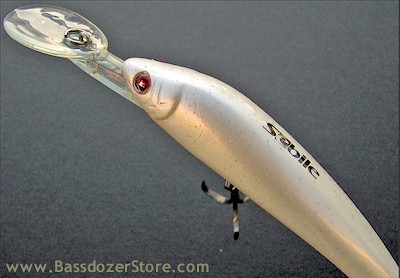
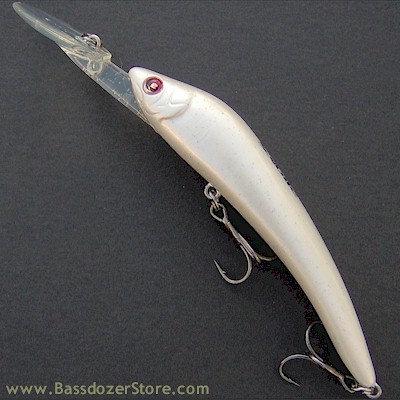

Sebile Koolie Minnow 90 LL ~ Deep Diving Jerkbait ~ White Lady
| Model | Length | Weight | Depth | Type |
| Onduspoon No. 3 | 5" (125mm) | 1-3/5 oz (45g) | 6 inches to 12 feet | Slow Sinking |
In Europe, the Onduspoon #3 is one of Sebile's most popular lures, and it is used for pike.
In North America, it's still fairly unknown and unused - but the Onduspoon #3 has one of the best actions of any spoon its size.
The Onduspoon not only works for largemouth bass, but is equally effective for pike, musky, walleye, salmon, striped bass or any gamefish that goes for spoons.
As far as largemouth bass fishing goes, the Onduspoon is a fairly big spoon, and it was not so long ago that such a big spoon wouldn't even be considered to be a bass lure, due to its large size.
In recent years, however, top bass pros in the USA have discovered that big, bulky spoons, generically called "flutter" spoons work for big bass. Everyday anglers have read of or watched pros on TV, and the demand for big bass spoons has blossomed in the USA.
The size of "flutter" spoons are similar in size to the Sebile Onduspoon, yet bass anglers haven't made the connection yet. Flutter spoons are stamped out of metal plate whereas the Onduspoon is molded of plastic.
Big bass will go absolutely crazy for the Onduspoon, and you can have this great bait all to yourself. Especially if you learn how to use it as I describe here now - as a sinking twitchbait. That's one Onduspoon presentation they almost can't resist. So try it with sinking, twitching movements. Give the Onduspoon small twitches as it sinks, and it will flip and flop in semi-circular gyrations that nearby bass cannot ignore. Cast it next to visible cover in shallow water and twitch it down to the bottom. In deeper water, you can vertical jig it off the bottom in the same manner.
Once it sinks to bottom or moves beyond the location where you feel you want to work it, you can just swim it over to the next bush, the next stick-up, grass clump, rock, tree stump or whatever piece of cover where a fish could be hiding, and then perform the sinking, twitching tactic close to the next fishy-looking hideout. It really is a fun and effective way to use the Onduspoon.
Once you master this sinking twitchbait tactic, you'll find it's a devastating technique. It works best when allowed to fall next to cover while you give it small twitches to make it flop and flash like a fluttering big baitfish that's in trouble.
Best of all, once you get the knack for that sinking twitchbait tactic with the Onduspoon, then it is very easy to transfer that skill to the Sebile Magic Swimmer. That's right, you can fish the Magic Swimmer just as described for the Onduspoon. The Magic Swimmer and Onduspoon are actually very similar lures when used as sinking twitchbaits in shallow cover or deep.
The Onduspoon may also be fished by retrieving steadily so it swims slowly in shallow water. It has a lifelike allure that few other spoons possess. In submerged grass, where you have a few feet of water above the grass, retrieving the Onduspoon steadily can be deadly.
It can be fished on bottom with a classic lift-and-fall jigging motion - and even trolled rapidly.
It's loaded with over twenty metal beads, so it has a loud, chattering rattle sound.
Keep in mind, the Onduspoon not only works for bass, but is equally effective for pike, musky, walleye, salmon, striped bass or any gamefish that goes for spoons.
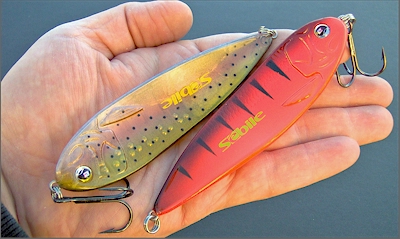
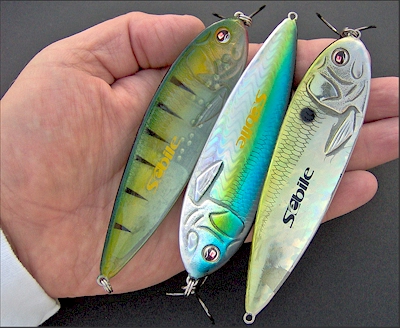
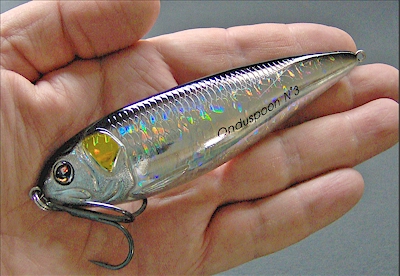
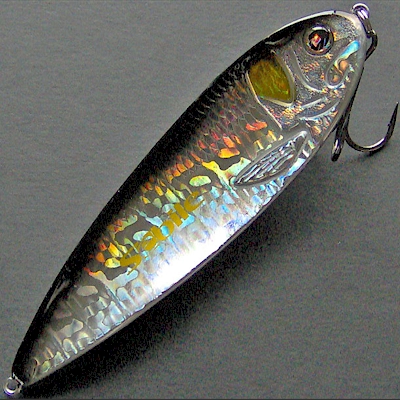
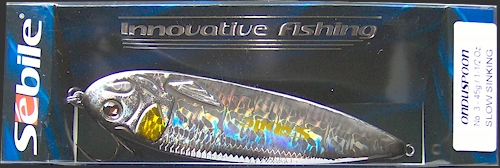
Sebile Onduspoon #3 - Natural Shiner
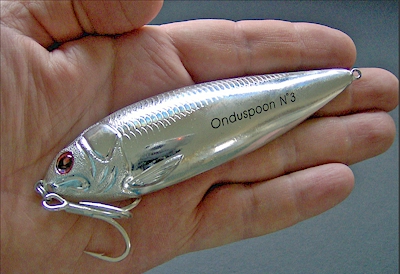
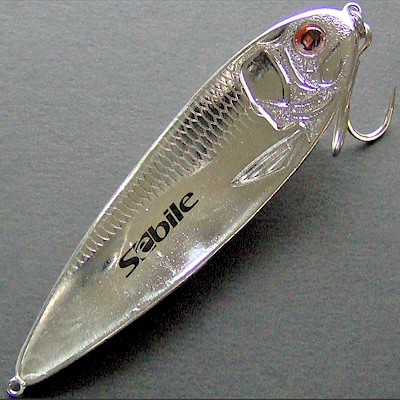
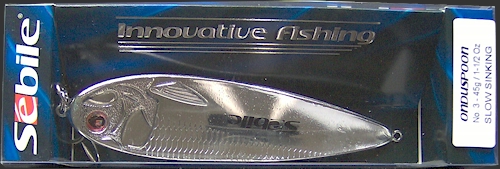
Sebile Onduspoon #3 - Silver
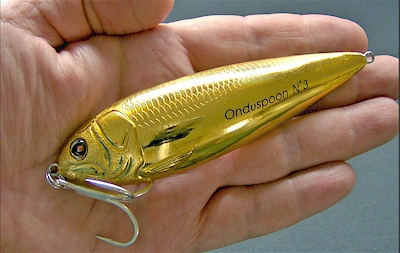
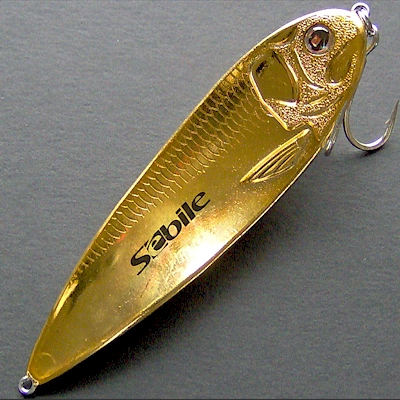
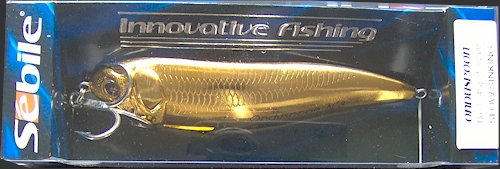
Sebile Onduspoon #3 - Gold
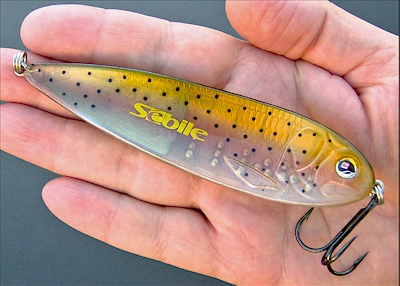
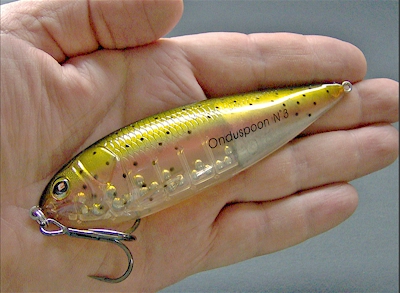
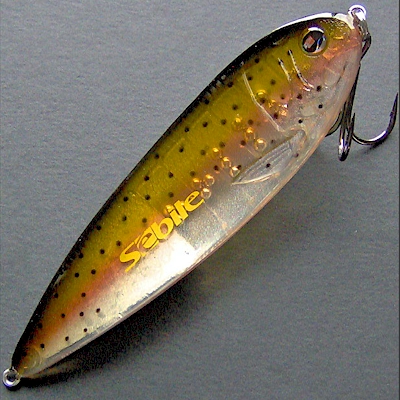
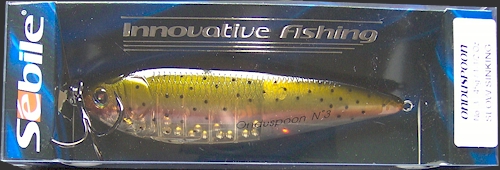
Sebile Onduspoon #3 - Natural Rainbow Trout
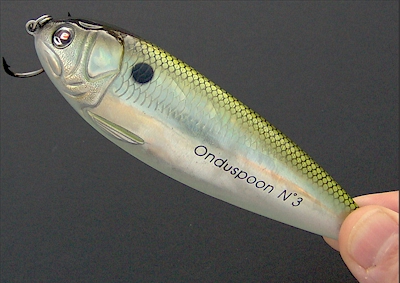
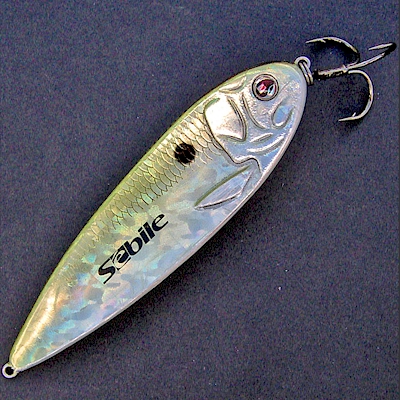

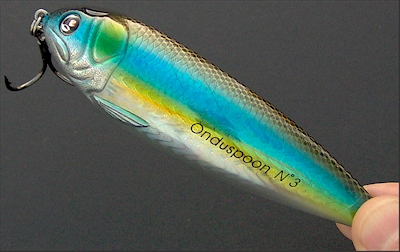
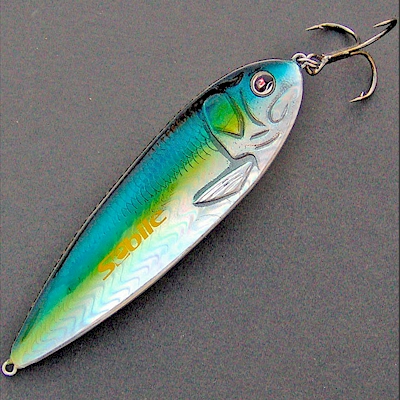

Sebile Onduspoon #3 - Blue Althea
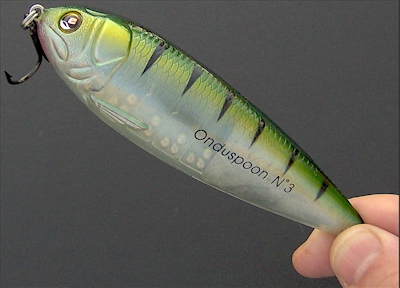


Sebile Onduspoon #3 - Natural Perch
To describe the SEBILE Splasher quickly, and how it's different from other poppers, the Splasher has a huge, deep bowl of a mouth, a blaring trumpet-shaped head, a water-slicing power keel that the belly hook is seated in, and whereas most other poppers are thinner on the sides (vertically), the Splasher's body is flattened horizontally, not full-round. Check one out for yourself, and you'll see the Splasher's shape is radically unique.
| Model | Length | Weight | Type |
| Splasher 120 | 5" (120mm) | 1-1/2 oz (42g) | Floating, Popping, Walking, Splashing |
| Splasher 90 | 3-1/2" (90mm) | 5/8 oz (17.4g) | Floating, Popping, Walking, Splashing |
| Splasher 72 | 3" (72mm) | 3/8 oz (10g) | Floating, Popping, Walking, Splashing |
| Splasher 52 | 2-1/4" (52mm) | 1/8 oz (5g) | Floating, Popping, Walking, Splashing |
All sizes of Splashers can not only pop and spray water, they can also walk from side to side.
The Splasher 120 is a large lure for trophy largemouth bass - and it is an ideal size for pike, musky and saltwater species like striped bass and bluefish.
| Model | Length | Weight | Type |
| Splasher 120 | 5" (120mm) | 1-1/2 oz (42g) | Floating, Popping, Walking, Splashing |
The Splasher 120 not only walks side to side but it can pop water to the left and to the right instead of straight ahead. It's the only lure I know that can do that - spray water to one side and then spray water to the other side, back and forth like that. Even the shorter sizes of Splashers (90, 72, 52) although they walk side-to-side, they only pop and spray water straight ahead. They can't really spray water to one side and then the other side like the 120 can. It's definitely a neat trick.
The Splasher 120 is through-wired meaning one single piece of heavy stainless wire runs from the front eye to the tail eye, running along the belly forming the belly hook hanger too.
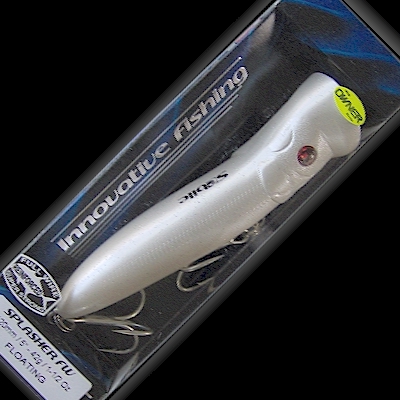
Sebile Splasher 120 ~ Topwater ~ White Lady
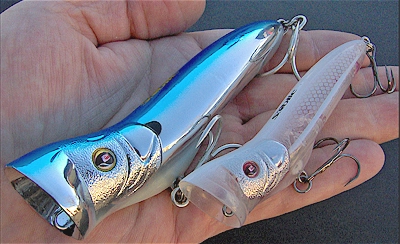
The size of the Splasher 120 (left) makes it selective for trophy
bass, whereas the Splasher 90 (right) is ideal for medium-sized
bass. The 90 is still pretty big compared to other poppers, but
nowhere near the 120's size.
The Splasher 90 can be cast a tremendous distance, practically emptying your reel spool. It throws a huge splash - if you want it to do that. Gentler rod actions will result in a more subtle splashing, spitting and walking action. It has a wide range of actions.
| Model | Length | Weight | Type |
| Splasher 90 | 3-1/2" (90mm) | 5/8 oz (17.4g) | Floating, Popping, Walking, Splashing |
With gentle rod tip movements, it can imitate a creature that's swimming and leisurely feeding on a hatch of small insects, for example. At the other end of the action spectrum, it can be made to generate quite a struggling, twisting, turning, distressed movement of a vulnerable critter flailing furiously on the surface. Due to the unique compound curves of the body, it's not a smooth, predictable, mechanical action like most other lures have. The body shape emits more of a panicked, struggling action of a creature in serious trouble.
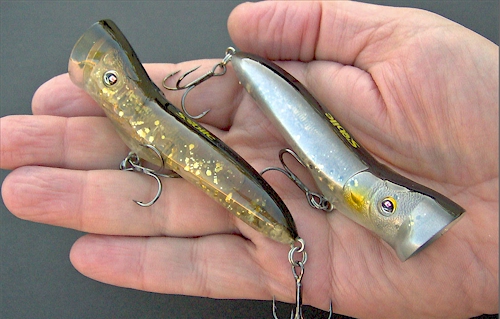
The Splasher 90 is a solidly-constructed topwater lure with
compound curves unlike any other.
When it sits in the water, the head is raised so only 30% of it's mouth is in water. The other 70% of the flared cup is put there to spit. It has the possibility to make a big splash - if you want to make sure bass know you are there. Most of the time though, you do not need to pop it hard to throw a lot of water. The Splasher 90 weighs 5/8 oz and is a good size for bass.
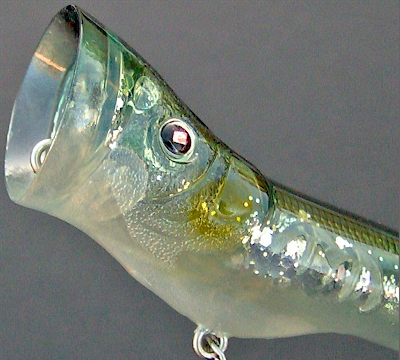
The Splasher's 'Power Keel' helps you walk the dog expertly with
this popper. If the Power Keel was cut off, the Splasher would go
almost straight, not walk at all.
The Splasher 90 is much bigger than your typical bass popper.
The Splasher 90 is not a light tackle lure. A moderately heavy topwater rod/reel/line can be used with it.
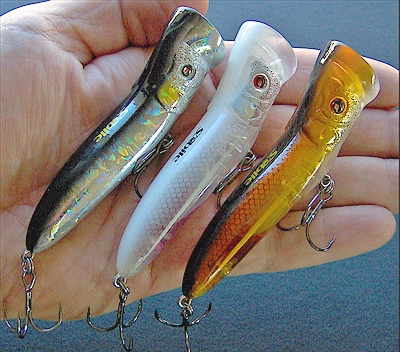
From L to R: Splasher 90 in Natural Shiner, Blood Red White and
Blood Red Amber.
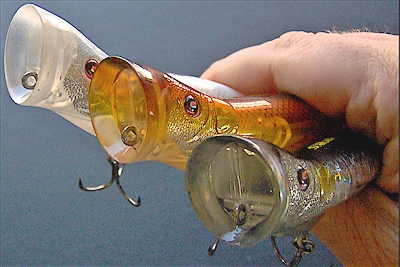
Deep bowl-shaped mouths of Splasher 90
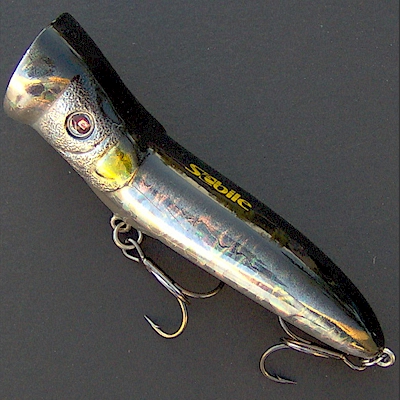

Sebile Splasher 90 ~ Topwater ~ Natural Shiner
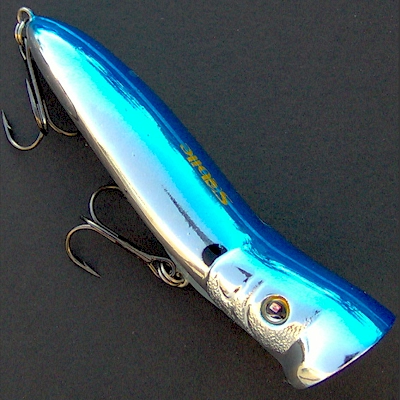

Sebile Splasher 90 ~ Topwater ~ Blue Chrome
The Splasher 72 is fun, easy to use, suited for light to medium tackle, and you can walk the dog with it so easily that it surprises many people. Also, thanks to the trumpet-like flared face, you can create huge commotions on top for such a little lure, which can attract fish from both afar and deep.
Thatís one of the secret tricks to using the Splasher, to create a huge splash at times, to let distant or deep fish know, "Hey, look at me. I am over here! Now come get me."
But if you want to create subtle splishes and spits, thatís easy to do too, along with the Splasher's zig-zaggy walk the dog action.
| Model | Length | Weight | Type |
| Splasher 72 | 3" (72mm) | 3/8 oz (10g) | Floating, Popping, Walking, Splashing |
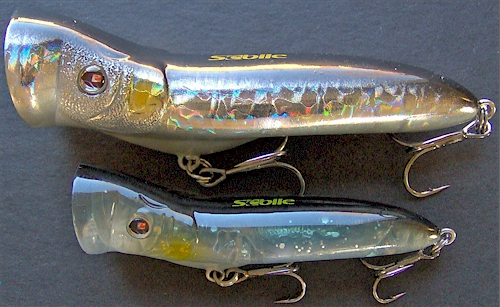
The Splasher 72 (bottom) is the closest match to the approximate
size of other common brands of bass poppers. However, the 72 is
relatively small in comparison to the bigger Splasher 90 (top).
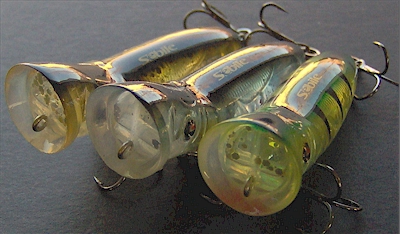
The business end of the Splasher 72.
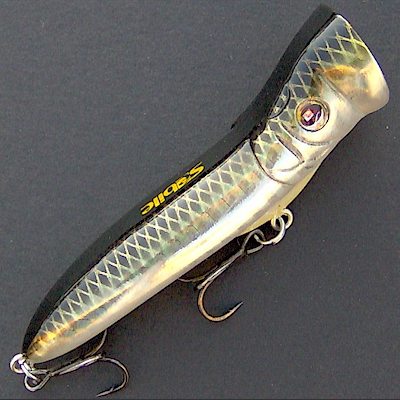

Sebile Splasher 72 ~ Topwater ~ Natural Mullet
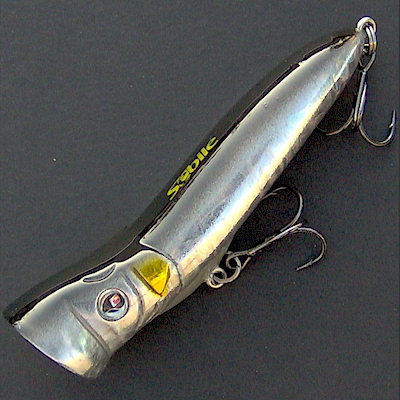

Sebile Splasher 72 ~ Topwater ~ Natural Shiner
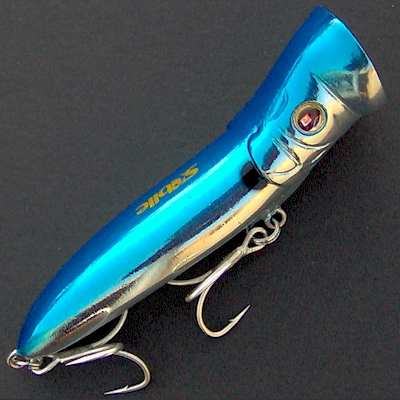

Sebile Splasher 72 ~ Topwater ~ Blue Chrome
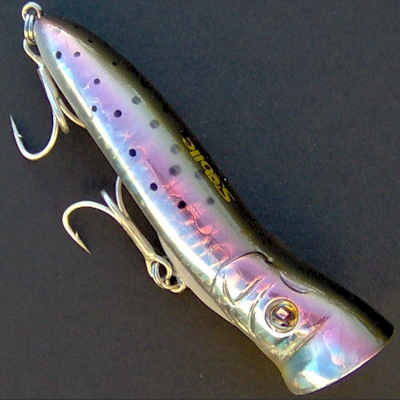

Sebile Splasher 72 ~ Topwater ~ Natural Sea Trout
The Splasher 72 and 90 are great lures right out of the box if you want to use them at slow to moderate speeds, and with very short rod tip movements. This kind of slow, deliberate tactic with plenty of pauses is often best under low light conditions, in dirty water, around thick cover, when the water is cold or during cold front passage conditions. The Splasher 72 and 90 have so much body action, even with shorter than usual rod tip movements, that they can be made to twist and turn almost in place, while hardly moving forward, and there are many times and conditions when bass want that - along with plenty of long pauses between movements of the popper.
On the other hand, there are times when and where the water is ultra clear, coverless, hot or under bright conditions, and then a fast-moving popper is often necessary. In clear, bright, coverless conditions, the distance of the lure from the fish and rapid lure speed are used to do what stained water, low light and dense cover do (help obscure the lure).
If you really want to turn up the speed of a Splasher 72 or 90, you'll need to add a "kite tail" to help stabilize the lure action a little when retrieved rapidly. You can either buy a replacement feather treble, or here's how to make one yourself, which is easy and takes all of 60 seconds.
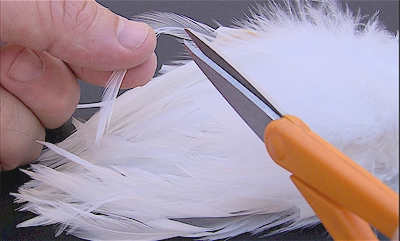
Clip four feather tips out of some strung saddle hackles.
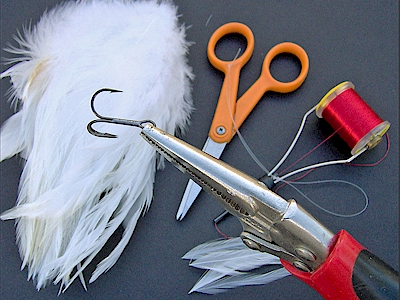
Clamp the tail treble off a Splasher 72 or 90 securely in a hand-held needlenose vise-grip pliers, and wrap the 4 feather tips one-by one onto the hook shank in between the openings between barbs.
Have the natural curve of each feather face inward in what flytyers call a "praying hands" effect.
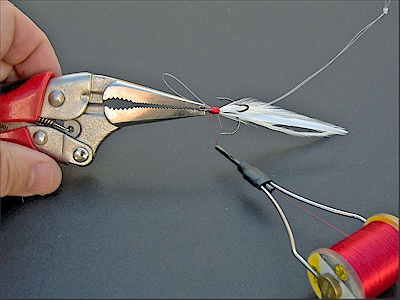
To finish, lay a loop of mono line onto the shank, and wrap the mono down same as you wrapped each feather. After about 10-20 wraps of thread, clip the thread and pass the tag end through the mono loop. Then pull the loop out from under the wraps, creating what flytyers call a knotless "whip finish" to secure the end of the thread under the wraps.
Finally, coat with clear nail polish and let dry. From start to finish should take under a minute.
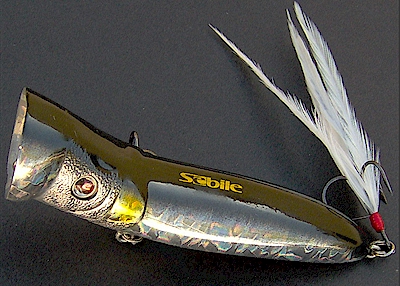
Splasher 90 shown above with feather tail. When the Splasher body
zigs to the left, the feather tail zags to the right and vice
versa, creating a supple, jointed, swimming look to the lure.
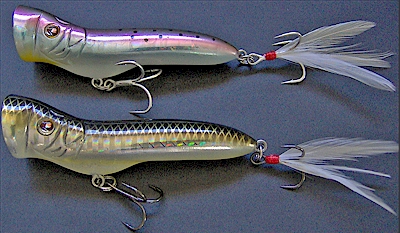
Two Splasher 72s shown in photo above. Both are same size (except
the camera angle causes the back one to appear smaller). What is
different is, #4 saltwater hooks on Splasher in back versus #6
freshwater hooks on Splasher in front. There's no significant
difference in the Splasher 72's action with either #4s or #6s. So
use either hook size matched to the rod, reel and line you'll
throw it on as well the size of fish you expect to catch.
The feather tail adds balance to the action of the Splasher 72 and 90. The Splasher 120 and Splasher 52 do not need this additional balance, but the 72 and 90 sizes perform just a little better (especially on fast, aggressive retrieves) with a feather tail than without one. So give it a try. It's like adding a tail to a kite, and helps balance the bait beautifully.
If you are fishing small ponds, streams, tanks, with ultralight tackle, for small bass, anytime you need to match an insect hatch or when bass are surface-feeding on "no see 'ems" (tiny baitfish), the Splasher 52 is the ticket.
The diminutive Splasher 52 has an absolutely perfect pop and walk. It pushes more water and wakes more than it pops (unless yanked on) but that is imitative of how small insects, baitfish or critters would behave when trapped on the water's surface film. The Splasher 52 (and creatures it imitates) is not one to make huge splashes - unless you want it to.
| Model | Length | Weight | Type |
| Splasher 52 | 2-1/4" (52mm) | 1/8 oz (5g) | Floating, Popping, Walking, Splashing |
You can fish the Splasher 52 with soft or hard rod action, and it will respond perfectly and true every time. When walked, each side step shows realistic change-up of hesitation to acceleration when jerked and paused - and that's really what you want in a walking popper - life-like acceleration and hesitation every time it's moved. I just can't say enough good stuff about this little gem of a popper.
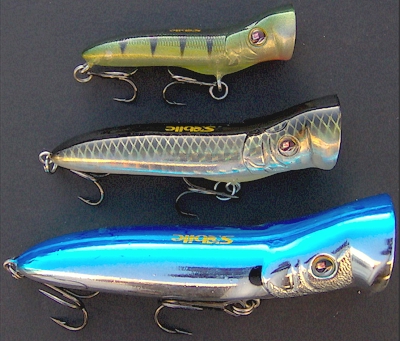
From top down: SEBILE Splasher 52, 72 and 90
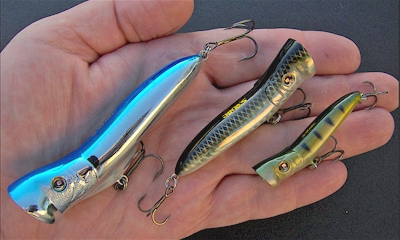
From L to R: Size comparison of Sebile Splasher 90, 72 and
diminutive 52.
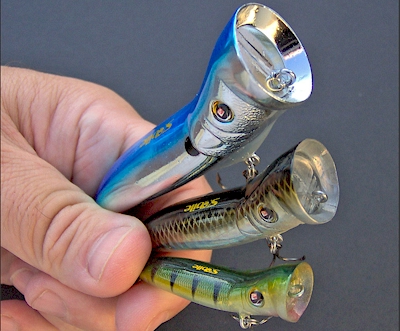
From top down: Blaring trumpet-shaped heads of SEBILE Splasher
90, 72 and 52.
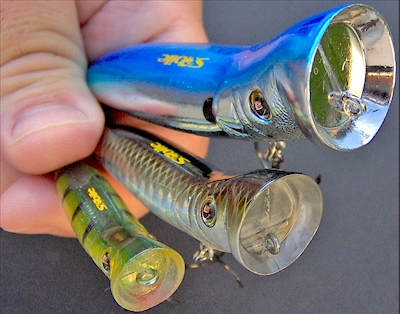
From top down: Deep bowl-shaped mouths of SEBILE Splasher 90, 72
and 52.
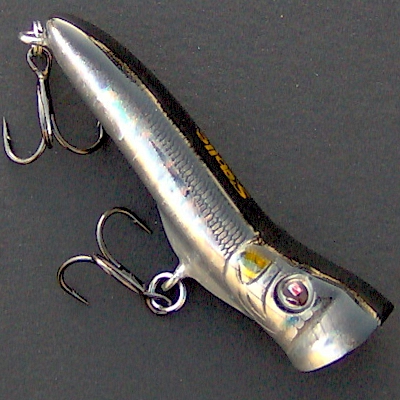

Sebile Splasher 52 ~ Topwater ~ Natural Shiner
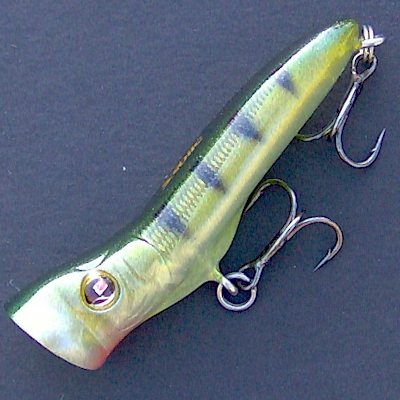

Sebile Splasher 52 ~ Topwater ~ Natural White Perch
The Stick Shadd is Patrick Sebile's own personal favorite model of all his baits.
Indeed, the Stick Shadd was everyone in the tackle industry's favorite at EFFTEX, the world's largest annual international tackle trade convention. Held in Rome, Italy in June 2008, the Stick Shadd in Sebile's Blood Red color won Best New Hard Lure 2008 by a landslide vote at EFFTEX.
The Stick Shadd models of most interest to bass anglers are likely to be the:
Sebile lures are new and original. The design concepts are unique and unfamiliar to anglers. What may seem complex at first is the Stick Shadd comes in three types:
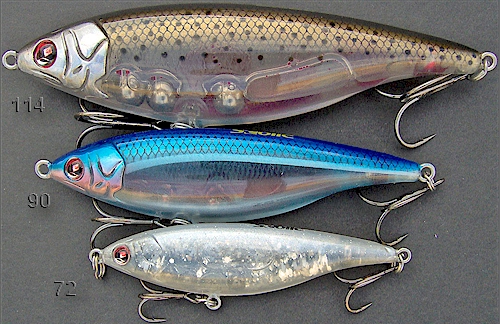
Sebile Stick Shadd comes in 3 sizes above of most interest to
bass anglers, and in floating, suspending and sinking versions.
| Model | Length | Weight | Running Depth |
Type |
| Stick Shadd 72 FT | 3" (72mm) | 1/3 oz (8g) | 0-1' | Floating, topwater/subsurface, walking, darting, jerking. |
| Stick Shadd 72 SK | 3" (7mm) | 3/8 oz (10g) | 1-4' | Sinking |
| Stick Shadd 90 FT | 3-1/2" (90mm) | 3/8 oz (11.6g) | 0-1' | Floating, topwater/subsurface, walking, darting, jerking. |
| Stick Shadd 90 SU | 3-1/2" (90mm) | 1/2 oz (14g) | 1/2 - 2' | Suspending. Shallow runner. Lipless jerkbait. Darts, jerks, walks. Suspends when paused. |
| Stick Shadd 90 SK | 3-1/2" (90mm) | 5/8 oz (18.2g) | 2-8' | Sinking, walking, jerk-and-pause,
wiggles as it falls. It's domain is 2-8' but can work topwater or on bottom (down to say 20') |
| Stick Shadd 114 FT | 4-3/4" (114mm) | 1 oz (26g) | 0-1 | Floating, topwater/subsurface, walking, darting, jerking. |
| Stick Shadd 14 SU | 4-3/4" (114mm) | 1 oz (28g) | 1/2 - 2' | Suspending. Low-floating. Topwater/subsurface. Twitch, dart, walk. Jerk-and-pause. |
| Stick Shadd 114 SK | 4-3/4" (114mm) | 1-3/8 oz (39g) | 2-12' | Sinking, walking, jerk-and-pause,
wiggles as it falls. It's domain is 2-12' but can work topwater or on bottom (down to say 20') |
"I use the FT, SU and SK Stick Shadd not as three versions of the same lure, but three different lures. That is the best mindset for using them," says Patrick of his favorite bait.
"If I must choose one, I can do everything with the sinking (SK) Stick Shadd from the top (of the water) down," says Patrick emphatically.
"The Stick Shadd has a thin keel that runs the length of the lure," says Sebile, "and the power of that keel creates small turbulences that activate the lure action. If you watch a shark in the water or on film, you'll see the tail move just a little to propel the shark. The shark moves so effortlessly because the shark has almost no friction as it moves through water. The rough skin has small turbulences all around, but the friction is fluid, water against water due to the irregular skin surface. It is the same idea on the Stick Shadd and the power keel helps create fluid water-against-water friction, allowing the bait itself to move more freely with less friction," states Patrick.
As Sebile spoke, it reminded me of how a boat hull runs faster and more friction-free in a short chop than across a flat surface. Also, how a boat hull with a little film of dirt adhering to it runs faster and more friction-free than a perfectly smooth, clean boat hull. So Patrick's 'power keel' principle of creating relatively friction-free, minute water-against-water turbulence makes a lot of sense.
Overall, the Stick Shadd represents a fairly new and unique lure type to the bass fishing world. True, there are plenty of topwater walking baits, and you could lump the Sebile Stick Shadd FT in with them. But, where do you put, what do you call the suspending and sinking versions of the Stick Shadd ? They're practically in a class by themselves - and can really only be called 'stickbaits'. This makes sense when you consider 'soft stickbaits' as for example, the Lunker City Slug-Go and the Zoom Fluke. Along those lines, the principle of the Sebile Stick Shadd may be considered a 'hard stickbait' in floating, suspending and sinking versions.
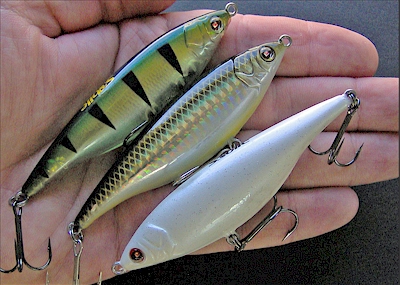
Stick Shadd 90 comes in three models that look identical: FT
(floating), SU (suspending) and SK (sinking).
All three Stick Shadd 90 models are fairly silent types (non-rattling), and share the same, very lifelike shaped body, and all have a sliding and side-to-side motion when worked with short rod movements. Depending how much rod tip movement is given to them. They are all able to look very nervous with short twitches, confused or disoriented with intermittent jerks, or frantic and distressed with an aggressive walk-the-dog action. The main difference between the three is: one floats (FT), one suspends (SU) and the other sinks (SK).
| Model | Length | Weight | Depth | Type |
| Stick Shadd 90 FT | 3-1/2" (90mm) | 3/8 oz (11.6g) | 0-1' | Floating, topwater/subsurface, walking, darting, jerking. |
The 90 FT is a fairly high-floating model of the Stick Shadd . It spends some but not all its time on top of the water. As you work it, when the sharp keel catches the water right, it will commonly knife under the surface. When that happens, it will tend to stay just below the surface. It will not slice very deep as you work it stays barely subsurface, and it's just one of the things that new anglers are going to have to get accustomed to with the unfamiliar Stick Shadds. With the rod tip low and some hard rips or strong rod action, you can keep it working under the water for a distance.
Part of the time however, it stays on top (especially with the rod held up) and can be made to walk very nicely in a manner similar to how you would work other topwater walking baits that zigzag across the surface. Key to the Stick Shadd, and an overall theme with many Sebile baits, is you do not have to move the rod tip very far at all - just a few inches - to bring out some of the very best and most consistent actions. With other lures, you need to work the rod a little harder and move the tip a further distance. With Sebile lures, you can work the rod tip a short distance, slowly and get tons of actions with little effort.
As with all hard baits that you work with the rod tip, there is a necessary degree of skill, experience, hand-eye coordination to produce the best results in terms of lure action. If you focus intently on what you need to do, you'll get the knack of just how to pull its string, and the Stick Shadd FT will produce handsomely for you.
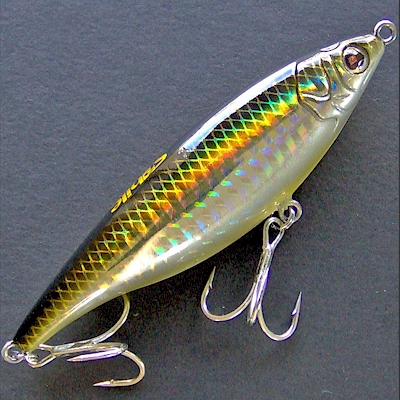

Sebile Stick Shadd 90 FT ~ Floating ~ Nat. Mullet
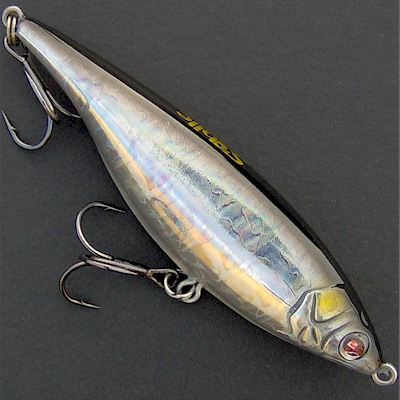

Sebile Stick Shadd 90 FT ~ Floating ~ Natural Shiner
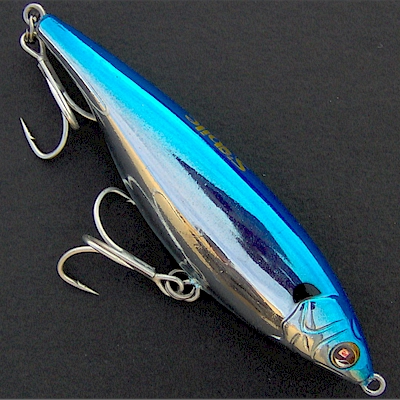

Sebile Stick Shadd 90 FT ~ Floating ~ Blue Chrome
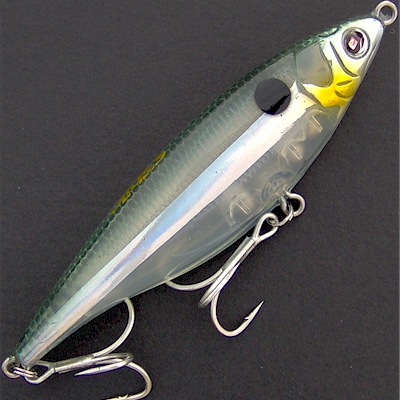

Sebile Stick Shadd 90 FT ~ Floating ~ Silver Liner


Sebile Stick Shadd 90 FT ~ Floating ~ Blood Red Blue
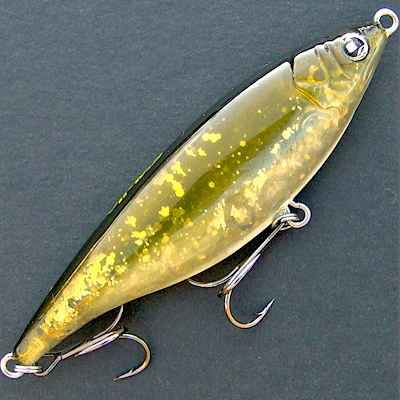

Sebile Stick Shadd 90 FT ~ Floating ~ Amber Fashion
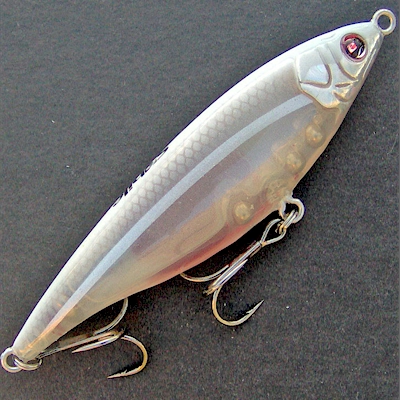

Sebile Stick Shadd 90 FT ~ Floating ~ Blood Red White
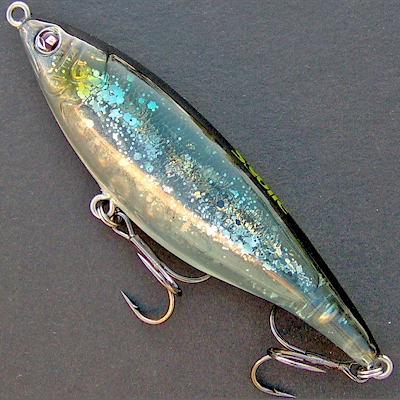

Sebile Stick Shadd 90 FT ~ Floating ~ Dark Blue Back
The Stick Shadd is a type of lure unfamiliar to most American bass anglers. Especially for bass fishing, it represents a fairly new and unique lure type.
But all you have to do is start catching fish with a Stick Shadd, and you'll want to use one all the time! That's just what happened with the Stick Shadd 90 SU. It is one of Sebile's best seller in salt water for snook, redfish, sea trout and everything else you can catch in Florida, Texas and the Gulf of Mexico. But the Stick Shadd 90 SU (and the 114 SU) is also a great bait for bass, especially for finicky fish as that is the ideal situation for which jerk-and-pause, suspending lures can work best.
If you are familiar with and have used 'soft plastic stickbaits' or 'soft jerkbaits' that are twitched, jerked and paused, then it isn't wrong to envision the 90 SU along those lines, except it's hard plastic and has treble hooks! But if you keep the concept of a soft plastic jerkbait in mind as you use it, you'll do just fine with the Stick Shadd 90 SU suspending stickbait. Please enjoy!
The Stick Shadd 90 SU is a dynamite bait on finicky fish. Depending on rod action used, it darts, jerks, walks and of course, suspends when paused, which often invokes a strike.
The Stick Shadd 90 SU is a shallow or you may say, subsurface runner. It typically works 1-2 feet deep, but rarely rises all the way to the surface.
| Model | Length | Weight | Depth | Type |
| Stick Shadd 90 SU | 3-1/2" (90mm) | 1/2 oz (14g) | 1/2 - 2' | Suspending. Shallow runner. Lipless jerkbait. Darts, jerks, walks. Suspends when paused. |
Also keep in mind, Stick Shadds come in FT, SU and SK models to fit all the needs you may have, from top to deep, with a lipless jerkbait, including the Stick Shadd 90 FT floating for fishing on or right under the surface, and the 90 SK which runs 2-8 feet deep.
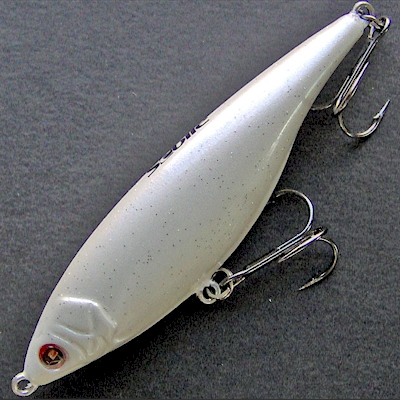

Sebile Stick Shadd 90 SU ~ Suspending Lipless Jerkbait ~ White
Lady
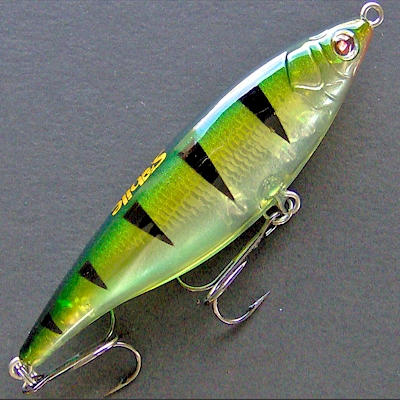

Sebile Stick Shadd 90 SU ~ Suspending Lipless Jerkbait ~ Nat.
Perch
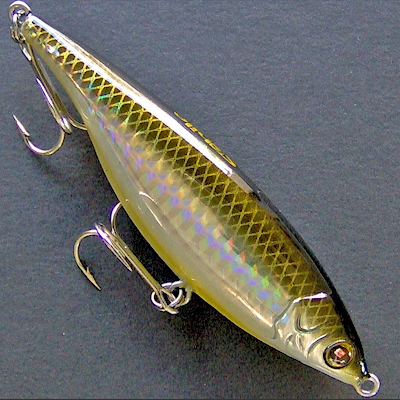

Sebile Stick Shadd 90 SU ~ Suspending Lipless Jerkbait ~ Nat.
Mullet
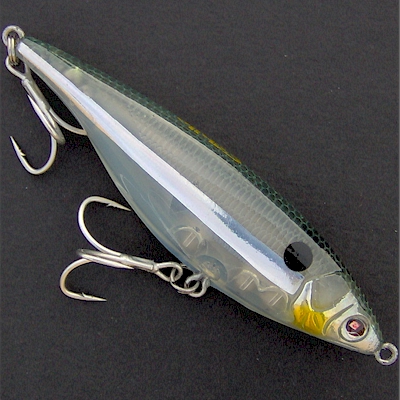

Sebile Stick Shadd 90 SU ~ Suspending Lipless Jerkbait ~ Silver
Liner
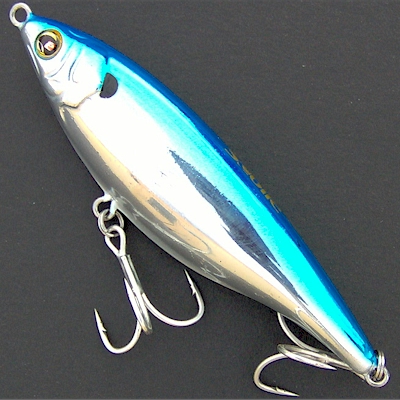

Sebile Stick Shadd 90 SU ~ Suspending Lipless Jerkbait ~ Blue
Chrome
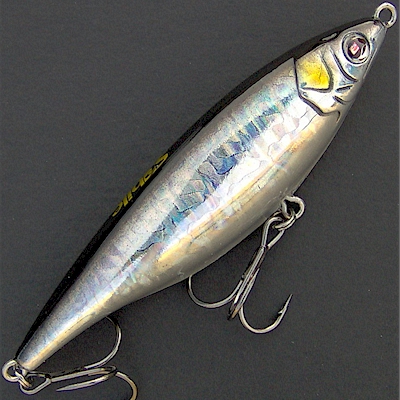

Sebile Stick Shadd 90 SU ~ Suspending Lipless Jerkbait ~ Natural
Shiner
| Model | Length | Weight | Depth | Type |
| Stick Shadd 90 SK | 3-1/2" (90mm) | 5/8 oz (18.2g) | 2-8' | Sinking, walking, jerk-and-pause,
wiggles as it falls. It's domain is 2-8' but can work topwater or on bottom (down to say 20') |
"If I must choose one, I can do everything with the sinking (SK) Stick Shadd from the top (of the water) down," says Patrick Sebile emphatically.
Indeed, with the rod tip high with a moderate reeling tempo, the 90 SK can be made to walk the surface effectively. Don't think lightly of this, as there are few other mid-running lures that can easily walk the surface like the 90 SK when called upon. So you essentially have a medium-running bait that will work at any level right up to on top of the surface.
In water down to 20' deep (or possibly deeper), this mid-runner can be stopped - and it will wiggle like a Senko, keeping a perfectly horizontal, flat body posture while shimmying straight down (not angling forward or backward) as it falls. Once it hits bottom pause and wait for a strike then. If no takers, lift it like you would a jigging spoon, and the 90 SK will have a side-to-side wiggle as you lift it. Then let it drop, and it will shimmy down on the fall, which is when you'll mostly get bit. Always wait for a fish to pick it off bottom in between lifts and falls.
On a steady retrieve, the 90 SK will have a built-in side-to-side action. You don't need to do anything except reel in to get that action.
On the fall, it will have the shimmy we described. You don't have to do anything except let it fall on a slack line to get that action.
In addition, there are two other actions you may want to try using your rod tip:
Give both the tactics above a try, and then improvise for what the fish want you and the 90 SK to do for them.
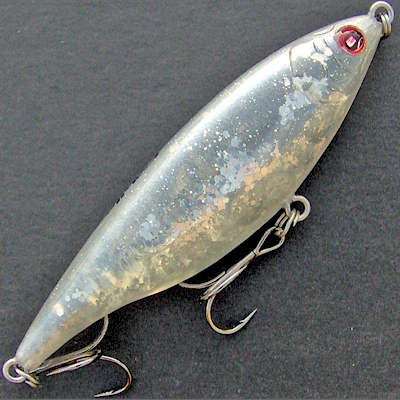

Sebile Stick Shadd 90 SK ~ Sinking ~ White Lady
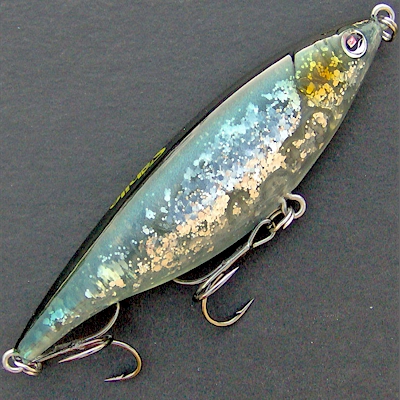

Sebile Stick Shadd 90 SK ~ Sinking ~ Dark Blue Back
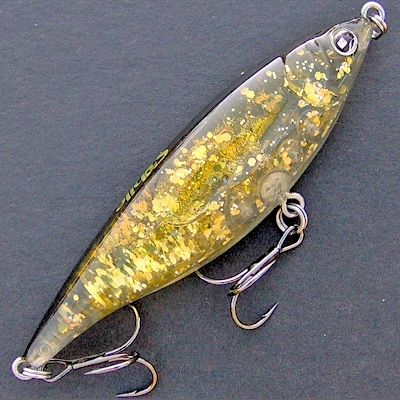

Sebile Stick Shadd 90 SK ~ Sinking ~ Amber Fashion
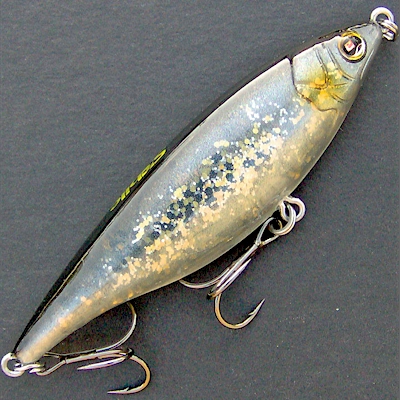

Sebile Stick Shadd 90 SK ~ Sinking ~ Hollow Mullet
| Model | Length | Weight | Depth | Type |
| Stick Shadd 114 FT | 4-3/4" (114mm) | 1 oz (26g) | 0-1 | Floating, topwater/subsurface, walking, darting, jerking. |
The FT is a fairly high-floating version of the Stick Shadd. It spends some but not all its time on top of the water. As you work it, when the sharp keel catches the water right, it will commonly knife under the surface. When that happens, it will tend to stay just below the surface. It will not slice very deep as you work it stays barely subsurface, and it's just one of the things that American anglers are going to have to get accustomed to with the unfamiliar Stick Shadds. With the rod tip low and some hard rips or strong rod action, you can keep it working under the water for a distance.
Part of the time however, it stays on top (especially with the rod held up) and can be made to walk very nicely in a manner similar to how you would work other topwater walking baits . Key to the Stick Shadd , and an overall theme with many Sebile baits, is you do not have to move the rod tip very far at all - just a few inches - to bring out some of the very best and most consistent actions. With other lures, you need to work the rod a little harder and move the tip a further distance. With Sebile lures, you can work the rod tip a short distance, slowly and get tons of actions with little effort.
As with all hard baits that you work with the rod tip, there is a necessary degree of skill, experience, hand-eye coordination to produce the best results in terms of lure action. If you focus intently on what you need to do, you'll get the knack of just how to pull its string, and the Stick Shadd FT will produce handsomely for you.


Sebile Stick Shadd 114 FT ~ Floating ~ Nat. Mullet
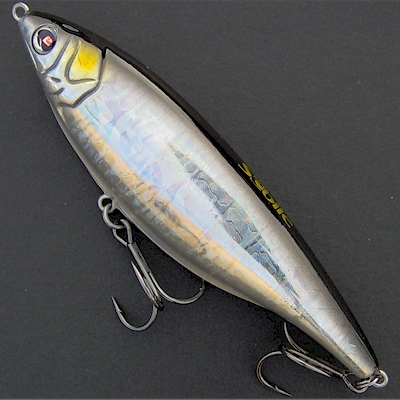

Sebile Stick Shadd 114 FT ~ Topwater ~ Natural Shiner
| Model | Length | Weight | Depth | Type |
| Stick Shadd 14 SU | 4-3/4" (114mm) | 1 oz (28g) | 0-2' | Suspending. Low-floating. Topwater/subsurface. Twitch, dart, walk. Jerk-and-pause. |
To understand the 114 SU, let's first discuss the 114 FT which is a high-floating version of the same.
The 114 FT floats high on the surface and for sake of discussion, let's say the 114 FT is somewhat comparable to other big topwater walking baits used for largemouth bass. The 114 FT mainly works on top, but can knife under the water (either intentionally or unintentionally) for a distance as you work or walk it.
Now then, the 114 SU can be worked on the surface roughly the same as how the 114 FT can be worked. The 114 SU is a low-floater that sits lower in the water, but with the rod tip help up, the 114 SU will mainly walk and stay on the surface, same as the 114 FT does.
The surface walking action is the same for both the 114 FT and 114 SU - but also there's enough difference that fish may prefer one's surface action over the other on any given day. In other words, some days it may seem the fish like the surface-walking action of the 114 FT. Other days, it may seen the surface-walking action of the 114 SU is the ticket. Still other days, the fish may hit them both equally - or not at all. Such is fishing!
But, to finish discussing the surface-walking features of the 114 SU, it can act much the same as the topwater 114 FT.
Furthermore, the 114 SU can be walked or jerked-and-paused subsurface, from a few inches to 1, 2 possibly 3 feet deep. The 114 FT cannot really do that (without a lot of work on the angler's part). So, this subsurface feature of the 114 SU may make it more versatile than the 114 FT version, if you follow me here.
The 114 SU can kind of do on the surface what the 114 FT does (but does not have exactly the same action as the FT). In addition, the 114 SU can work subsurface and since it suspends, offers the option of a jerk-and-pause tactic too, similar in concept to a shallow-diving suspending plastic-lipped jerkbaits that are common for bass. The difference is, popular plastic-lipped jerkbaits have lips that make their bodies roll or wiggle whereas the Stick Shadd 114 SU is a lipless jerkbait that can be twitched, darted, jerked, ripped or walked underwater - but doesn't wiggle since it's lipless. If you think of a soft plastic jerkbait action, you can do everything a soft jerkbait does with the Stick Shadd 114 SU, okay?
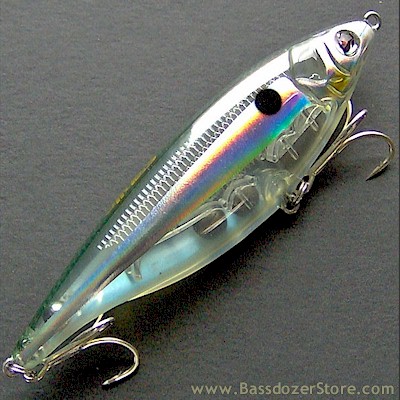

Sebile Stick Shadd 114 SU ~ Suspending Lipless Jerkbait ~ Silver
Liner
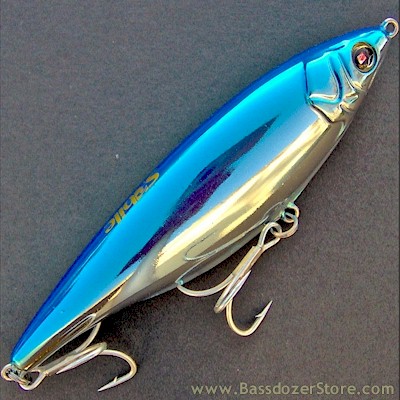

Sebile Stick Shadd 114 SU ~ Suspending Lipless Jerkbait ~ Blue
Chrome
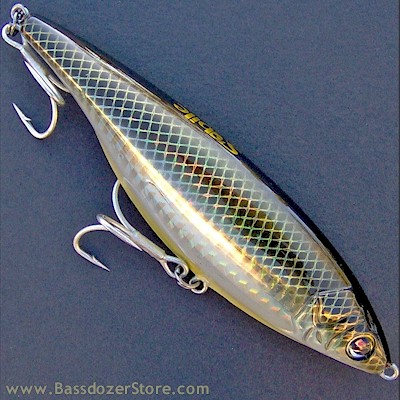

Sebile Stick Shadd 114 SU ~ Suspending Lipless Jerkbait ~ Nat.
Mullet
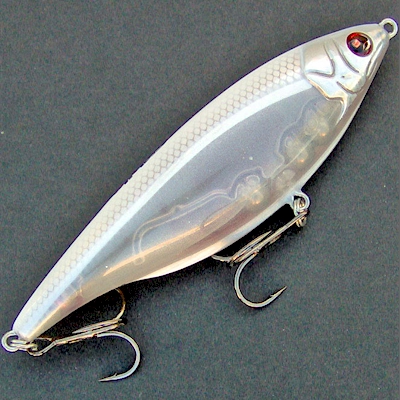

Sebile Stick Shadd 114 SU ~ Suspending Lipless Jerkbait ~ Blood
Red White
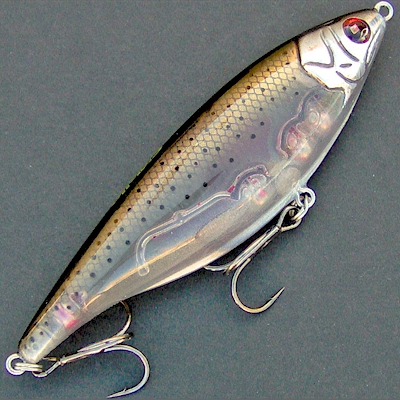

Sebile Stick Shadd 114 SU ~ Suspending Lipless Jerkbait ~ Blood
Red Dark
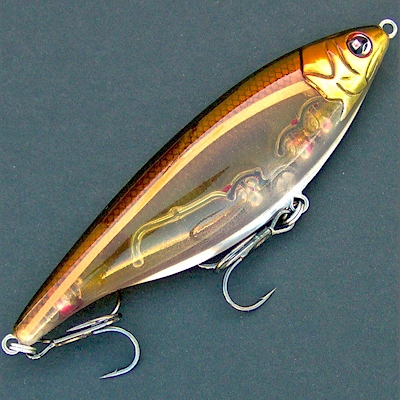

Sebile Stick Shadd 114 SU ~ Suspending Lipless Jerkbait ~ Blood
Red Amber
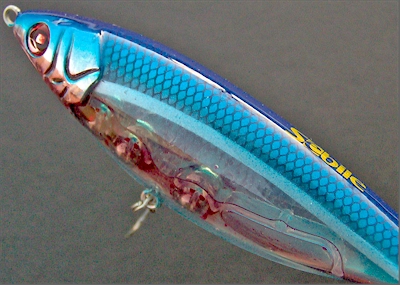

Sebile Stick Shad 114 SU ~ Suspending Lipless Jerkbait ~ Blood
Red Blue
| Model | Type | Length | Weight | Depth |
| Stick Shadd 114 SK | Sinking | 4-3/4" (114mm) | 1-3/8 oz (39g) | 2-12' |
This is a big heavy bait, and except for some large swimbaits, most anglers do not normally use such big, heavy baits as the Stick Shadd 114 SK.
Still, if you plan to fish for big bass, the Stick Shadd 114 SK is ideal!
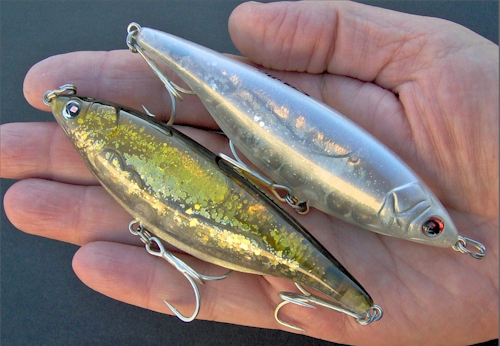
Make no mistake, the Stick Shadd 114 SK is big, heavy and
requires a beefy rod to handle it best.
At 1-3/8 ounce it casts far and sinks quickly. It sinks with a swagger, and tends to sink tail first, backward diagonally, swaggering side-to-side as it falls. It won't spin or foul easily as it falls, and you can let it sink as deep as you like and work it with a lift-and-drop action up and down off the bottom like you would a jigging spoon. It will exhibit side-to-side action on the lift and also side-to-side action on the drop.
Also simply reeling steadily, the 114 SK will swagger side to side on its own, without you needed to do anything except reel in line.
It only requires small, you can even say gentle, rod tip movements - just a few inches is all - to make it walk smartly side-to-side underwater. With the rod tip high, it can even walk on or just below the surface if that's what you need it to do, but it's true domain is from a few to 12 feet deep. There are not that many other sinking stickbaits that are used to walk the dog underwater, so do give it a try. You may like it!
Just remember, it is a beefy bait for big bass and takes stout tackle to use it. Now, this doesn't mean to use a flipping stick, which would be too stiff to get the best walking action. One like you'd use to launch a Super Spook for starters, spooled with possibly even heavier line than you'd use for that- or better yet, something more like a heavy crankbait rod for deep divers like Norman DD22's and such. It really depends what rods you've got, but start with the beefiest 'reaction bait' stick you've got. This is a heavy bait.
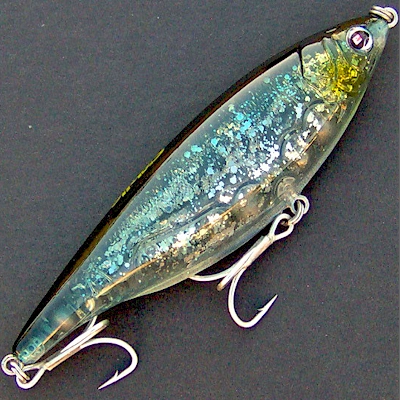

Sebile Stick Shadd 114 SK ~ Sinking ~ Dark Blue Back
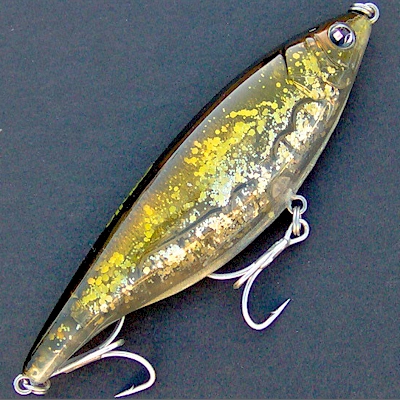

Sebile Stick Shadd 114 SK ~ Sinking ~ Amber Fashion
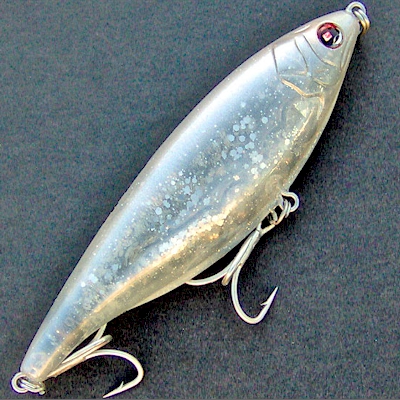

Sebile Stick Shadd 114 SK ~ Sinking ~ White Lady
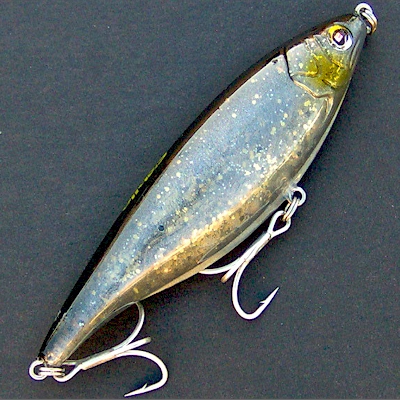

Sebile Stick Shadd 114 SK ~ Sinking ~ Hollow Mullet
Model: Stick Shadd Soft 100. Pro Pack*
Type: Slow sinking soft plastic hollow stickbait/jerkbait.
Length: 4 inches (100mm)
Weight: 1/4 oz (4.4g)
Depth: Swims weightless from 0-3 feet. Can be weighted with
Sebile soft tungsten weights and twitched down to 8 feet
Other Rigging Methods: Jig head, dropshot rig, wacky rig, Texas
rig, Carolina rig are recommended
*Note: Pro Pack includes 4 soft lures, 1 hook, 6 Sebile soft tungsten weights
The Sebile Stick Shadd Soft is a hollow soft plastic bait designed to be every bit as effective and versatile as Sebile's original Stick Shadd hard plastic lure - but with extra advantages such as weedless rigging!
It's possible to use the Stick Shadd Hollow any way you'd rig a soft bait, on a jig head, dropshot rig, wacky rig, Carolina rig or Texas rig.
The Stick Shadd Hollow's belly is shaped into Sebile's signature "Power Keel" that provides the amazing, unpredictable and lifelike swimming, darting and sliding action that brings the Stick Shadd to life when you twitch or jerk it during the retrieve. The Power Keel principle is the same used on Sebile's hard plastic Stick Shadd series.
The Pro Pack includes a stout, offset-neck single hook for weedless rigging in either fresh or saltwater. This gives you the ideal size hook to use, and Sebile provides six soft tungsten weight rings to slide on or off the hook shank. Each individual sinker ring is 1/32 oz, so you can add from one to six weights (or 1/32 to 3/16 oz) to the hook shank.
The soft tungsten rings can be positioned on the hook shank toward the nose of the bait to make it fall faster for instance to dive toward bottom underneath floating weeds - or the soft tungsten weight rings can be slid toward the back end of the hook, to get a more horizontal fall.
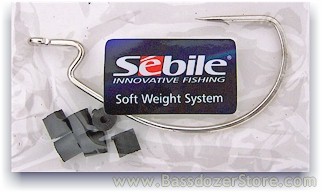
To rig weedless, use the Sebile Soft Weight System for best results and to easily add or remove weight to fine-tune your presentation. Insert the hook through the lure's nose, come out under the chin and add the special tungsten soft weights ontothe hook shank before inserting the point through the belly. The Stick Shadd Soft has a hollow hook envelope inside, to help shield the hook point from any potential snags When rigged properly, the point sits protected inside the lure's body, nestled within the protective pocket within the lure. For weedless rigging, peel the thin flap of skin (Sebile calls it the "Easy Strip") from the lures back with your fingers. However, the hook point stays hidden inside the slot, until a fish bites, when the hook slides out of the slot easily.
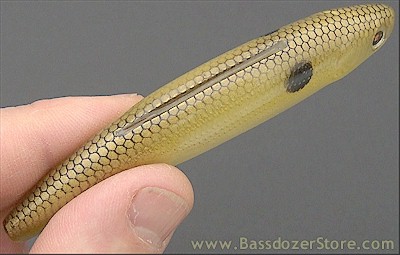
Removable "Easy Strip" peels off for easier hooksets
when rigged weedless. The Easy Strip does not need to be removed
to use jig heads, dropshot rigs, wacky rigging, etc. Leave Easy
Strip in place for added support when using a jig head, etc.

The Stick Shadd Hollow's shape makes it excel for skipping far
under docks, overhanging trees or brush, mangrove roots or other
obstacles.

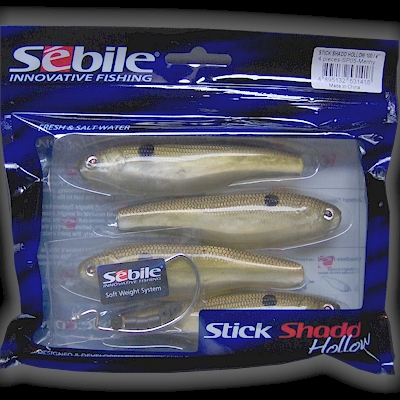
Sebile Stick Shadd Hollow ~ Pro Pack ~ Menhy (includes 4 soft
lures, 1 hook, 6 Sebile soft tungsten weights)
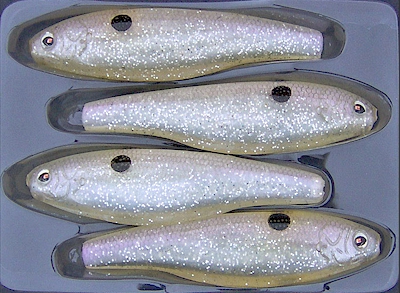
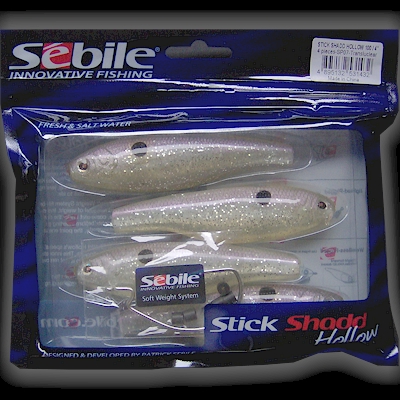
Sebile Stick Shadd Hollow ~ Pro Pack ~ Transluclear (includes 4
soft lures, 1 hook, 6 Sebile soft tungsten weights)
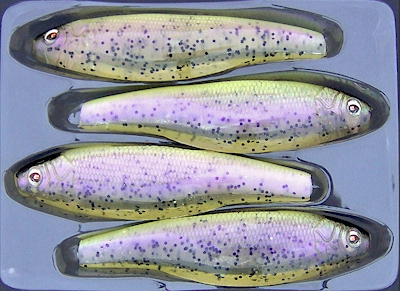
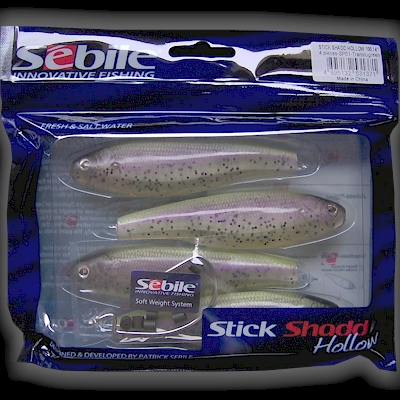
Sebile Stick Shadd Hollow ~ Pro Pack ~ Translugreen (includes 4
soft lures, 1 hook, 6 Sebile soft tungsten weights)
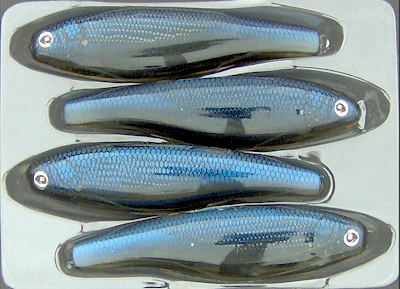
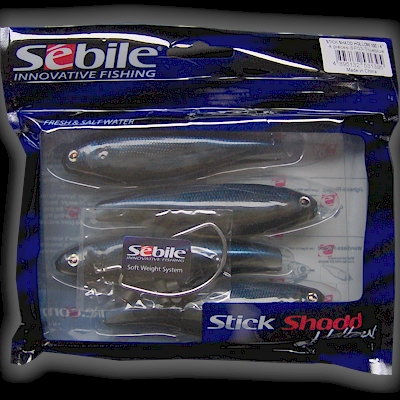
Sebile Stick Shadd Hollow ~ Pro Pack ~ True Blue (includes 4 soft
lures, 1 hook, 6 Sebile soft tungsten weights)
Despite its unusual appearance, the Proppler Buzz is an effective fish catcher. It has a mouse-shaped, hollow, sealed, floating hard plastic body on the top arm of the heavy wire that spins and churns the water when retrieved - plus it rattles.
It does not always stay right on the surface during the retrieve, but can be made to dive and stay a couple inches under the water. Fish belt it either way - on the surface or barely subsurface.
It can be buzzed steadily up to or right through thick cover.
It is very, very good for heavy cover. It can crawl right up, over and through bushes!
It floats when paused. It can be paused adjacent to cover and ripped to make a huge tear on the water surface. Be prepared for explosive strikes when you rip it.
The cast lead head has a trailer keeper barb molded into the collar plus an oversized hook. The skirt is hand-tied to the collar.
The entire lure weighs almost one ounce (25g).
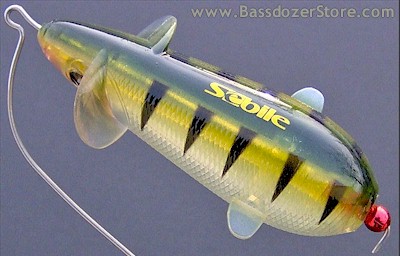
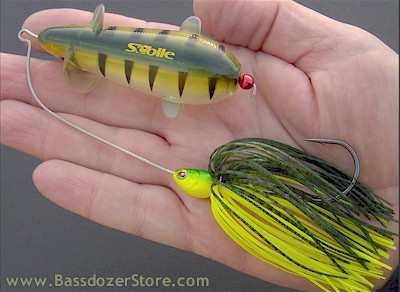
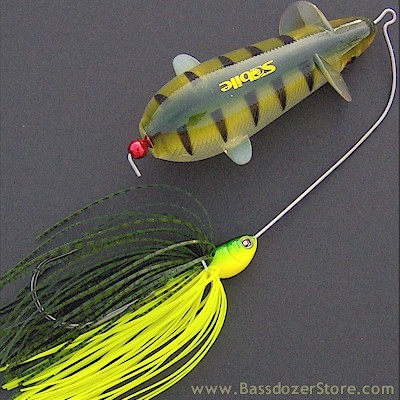

Sebile Proppler Buzz No. 2 ~ Natural Perch
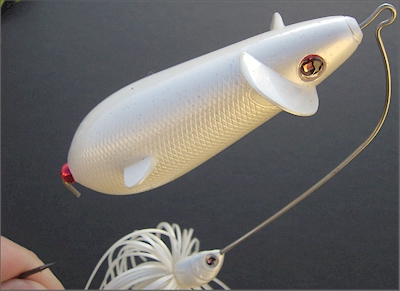
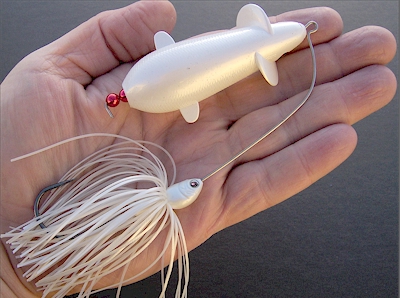
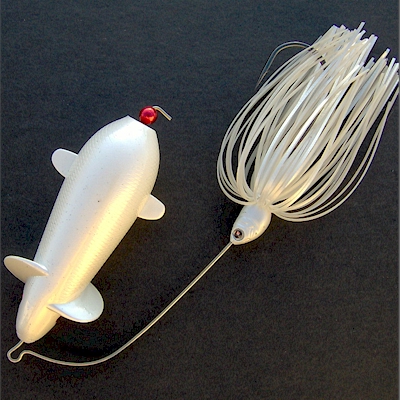
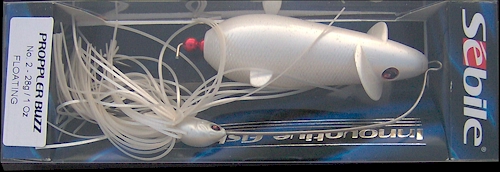
Sebile Proppler Buzz No. 2 ~ White Lady
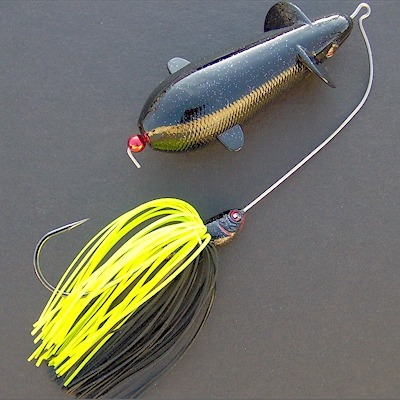
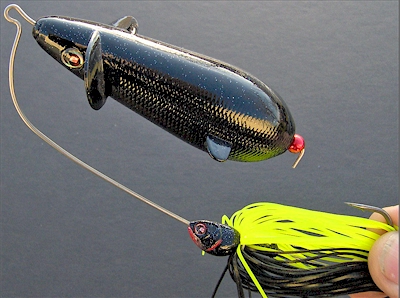
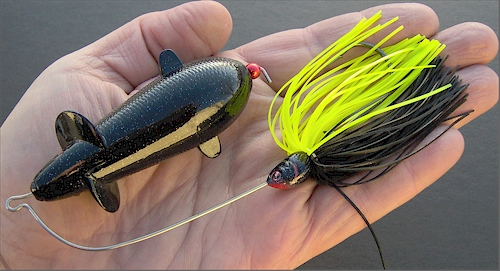

Sebile Proppler Buzz No. 2 ~ Black Chartreuse
The Spin Shad is a heavy alloy-metal, environmentally-friendly bismuth, molded inside a hard plastic body shell adorned with intricate baitfish detail. The attractive paint finish is extremely durable and resists ordinary abrasion. The blade finish is also quite durable and matches the body.
The forward line tie eye position and lure balance produce vibration of the Spin Shad body while the unique Sebile Shad Blade design on an in-line swivel allows the blade to spin at all retrieve speeds.
Overall, the Spin Shad combines the best features of a lipless vibrating crankbait body and a tailspinner. The tail blade is designed to constantly spin and vibrate, rocking the entire body.
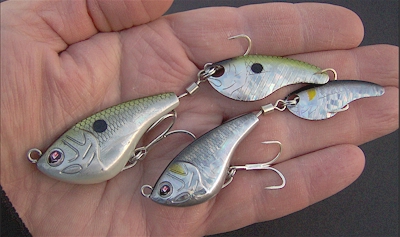
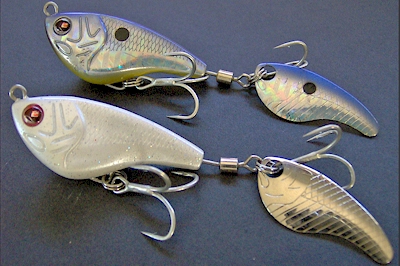
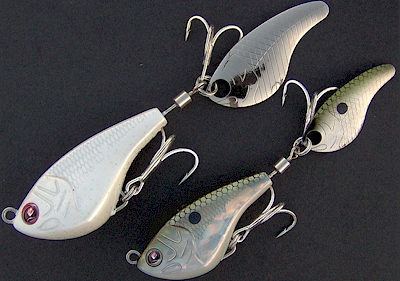
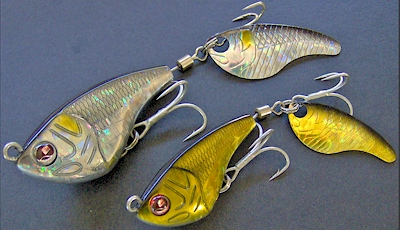
Size comparisons of smaller Spin Shad #1 (3/4 oz) and larger Spin
Shad #2 (1-1/4 oz).
There are two ways an angler (or fish) can look at the Spin Shad's shad-shaped body and matching shad-shaped spinner blade:
It's a universal baitfish (or school of baitfish) presentation that appeals strongly to any small to medium predator species in fresh or saltwater. It can be used with or without a wire leader, and both hooks are super strong, super sharp saltwater strength and finish - but the hooks are equally suited for any freshwater application.
The Spin Shad may be counted and fished at any depth from very shallow to very deep. It casts like a bullet, incredibly far, but due to the body shape and blade, it fishes very light for its size.
It comes in 3/4 oz & 1-1/4 oz sizes. Especially for freshwater bass anglers, many may not used to fishing tailspinner lures as heavy as 3/4 oz or 1-1/4 oz. Bass anglers are accustomed to lighter lures than this - but fear not. Give both sizes of the Spin Shad a try, and although heavier, you'll find they fish "light" for their weights. To highlight the differences between the two sizes:
The Spin Shad is a lure type known as a tailspinner. SEBILE certainly did not invent the tailspinner. Lures of this style have been around for many decades. But Sebile certainly did reinvent and revolutionize this venerable, old lure style with the introduction of the Spin Shad. There's a good chance that the Spin Shad will bring new ease and productivity especially to deep water fishing for all small to medium freshwater gamefish - bass, walleye, perch, striped bass, deep trout or anything else. In saltwater, for small to medium gamefish of many varieties, the Spin Shad is already proving successful beyond many anglers expectations. It's dense body works admirably in areas of current, greater depth or in stiff breezes, due to the body's density. This is an amazing, modern tailspinner design, unlike any tailspinner before it. It is a universal and productive fish catcher in terms of the species it appeals to, the conditions, depths and locations it may be fished.
One of the design goals that Sebile achieved in the Spin Shad is to have the blade spin constantly. As soon as it hits the water, the blade starts to spin. Retrieving it at almost any speed, while it's paused or free-falling, when you jig or twitch it, or when the Spin Shad is moving by any means, the blade is almost always working. You may even change the retrieve speed, twitch it, stop it, and the blade will hardly miss a beat. It's hard to stall or stop the blade. So you have constant flicker, flash and vibration to attract fish. That vibration of the blade also causes the body to rock, quiver and shake in an attractive way. So the blade is always working, flickering, flashing, and the body almost constantly shakes from the blade vibration.
A second design goal that Sebile accomplished in the Spin Shad is that it will stay at any desired depth. Why? One reason is because the blade shape does not generate a lot of torque or water pressure and it doesn't pull hard against the rod tip. This means the Spin Shad will not rise up in the water from the blade pressure. It will not pull against your rod tip and rise up. This lets you count the Spin Shad down to any level, from just below the surface to sixty or more feet deep, and with steady reeling, the Spin Shad will stay at the desired level. Naturally, you should reel a little faster to maintain a level high in the water column, reel at a moderate speed to keep the Spin Shad at mid-depths, and reel slowly to keep the Spin Shad deeper down for the entire retrieve. At the correct retrieval speed, you have one lure you can use at almost any level, and it won't ride up. Plus it's a bottom-bouncing beauty at any depth.
So as soon as the Spin Shad hits the water, the blade starts working and it keeps working constantly until the retrieve ends. Plus as long as you let it sink or count it down in the water column, you can retrieve it at any level and it won't ride up since it doesn't pull hard against your rod tip.
There are three basic hook options to try depending on the conditions. The action and performance of the Spin Shad does not change very much with the different hook options. The blade turns a little slower with more resistance and revolves in a little wider arc with the tail treble attached. The blade spins a little more freely, easily, will revolve faster and tighter when you take off the tail treble - but none of the hook configurations below drastically change the overall action.
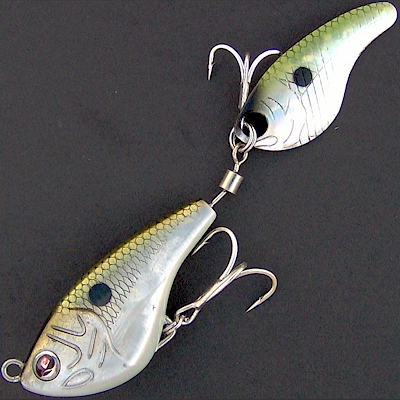
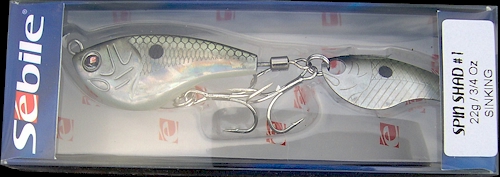
Sebile Spin Shad #1 ~ 3/4 oz Tailspinner ~ Holo Greenie
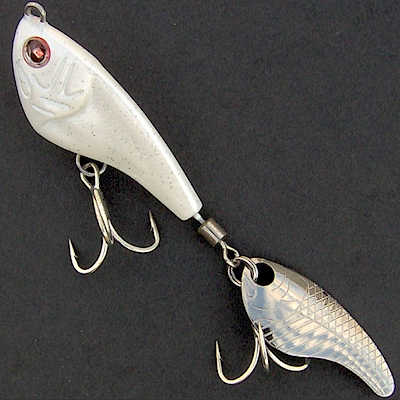
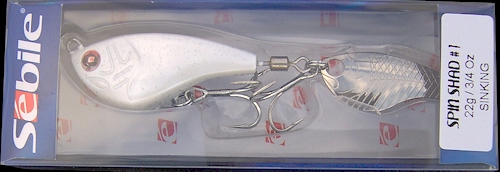
Sebile Spin Shad #1 ~ 3/4 oz Tailspinner ~ White Lady
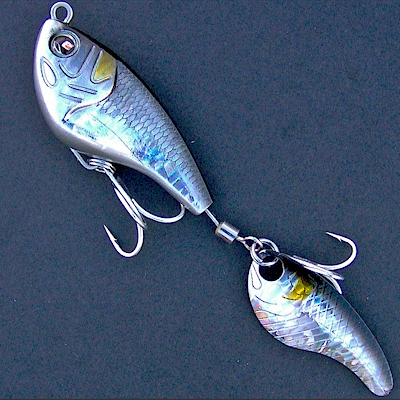
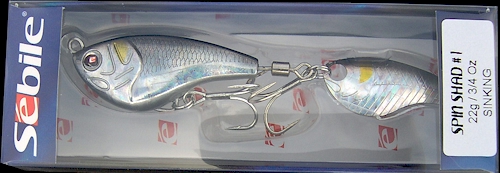
Sebile Spin Shad #1 ~ 3/4 oz Tailspinner ~ Natural Shiner

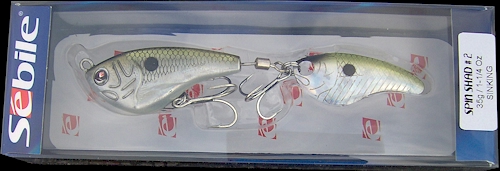
Sebile Spin Shad #2 ~ 1-1/4 oz Tailspinner ~ Holo Greenie
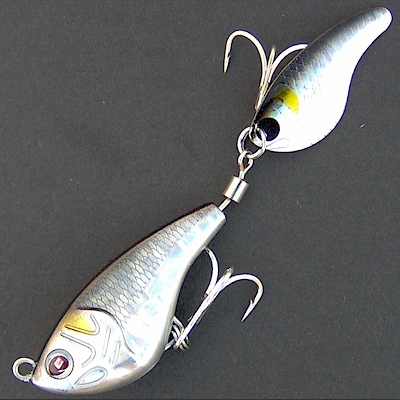
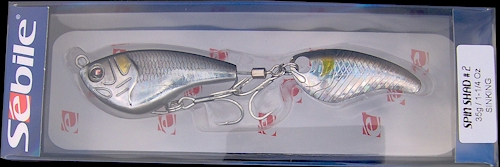
Sebile Spin Shad #2 ~ 1-1/4 oz Tailspinner ~ Natural Shiner
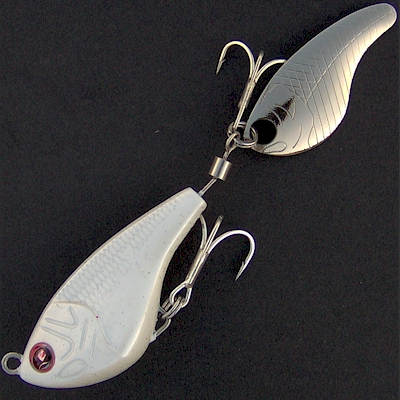
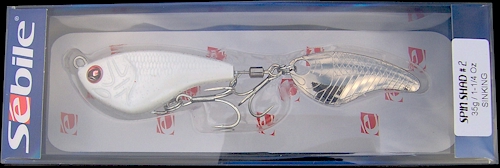
Sebile Spin Shad #2 ~ 1-1/4 oz Tailspinner ~ White Lady
Early spring, say February through April or May, is the most popular period for tourist anglers to make their annual pilgrimages to Mexico, the Mecca for trophy bass possibilities!
In recent years, trophy bass fisheries have been developed on shared international boundary waters too - Amistad and Falcon - large reservoirs which the US/Mexican border runs through them.
Next time you go to Mexico, why not take a few of the following Sebile lures with you? They are all ideal choice for Mexican bass fishing. Some of the baits below will excel for catching large numbers of bass in Mexico, and others will appeal more to those big trophy fish which are everybody's dream!
Of course, many anglers today know the Magic Swimmer - but some of the other models listed here, you may not have heard of them yet. Don't worry that they are unfamiliar. Just have fun with them!
If used properly, all the models will all work for you. Once you get the knack, they are absolutely sensational lures. So give them a try!
Fishing in Mexico, I recommend baitcasting reels and rods. Specifically for Sebile lures, a rod designed with an extra fast or fast rod tip action seems best. Try to avoid a rod that has a slow, soft or soupy rod tip action when using Sebile lures. Often braided line works best with Sebile lures, coupled with the extra fast or fast rod, and make short movements of the rod tip.
On some of the more massive lures listed below, 50-60 pound test braid is workable. For some of the other relatively smaller models below, you may prefer to work them with, for example, 30 pound braid.
The purpose of this write-up is not so much to give you tips how to fish these lures. Instead I simply desire to identify and to recommend what may be the best Sebile models for bass fishing in Mexico.
I will share this advice though. One key to fishing all or most Sebile lures it seems, is to use smaller rod movements than typical to impart action. If you work them hard like you do a typical popper, walking bait or jerkbait, that is probably going to be too much rod action. Consider using small, steady and controlled rod movements of only a couple inches most of the time. The Splasher models and the Proppler Buzz are exceptions to this advice, since with them, you can occasionally rip them hard in order to tear up the water surface, attracting attention that way. But otherwise, short, deliberate rod tip movements often seem key to unlocking Sebile lure actions - especially with extra fast or fast tip rods and braid.
Good luck fishing for big, strong bass in Mexico with Sebile lures!
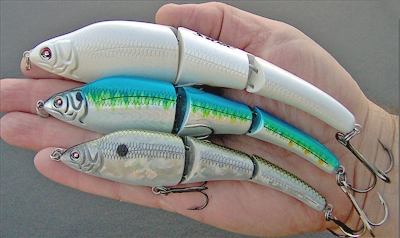
The Magic Swimmer swimbait is the one everyone's heard of,. From
top down: 1) Magic Swimmer 165, 2) the fast-sinking Magic Swimmer
145 FSK, and 3) Magic Swimmer 125 are the three ideal sizes to go
to Mexico.
A tip on the Magic Swimmer 125 is to replace its hooks with bigger #2 trebles on the 125 size swimbait.
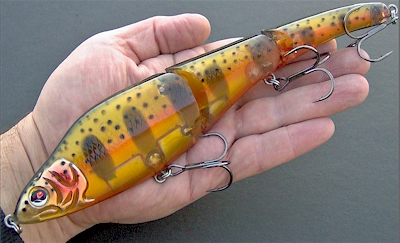
Now if you really want to latch onto that trophy bass of a
lifetime, then take the Magic Swimmer 228 to Mexico.

Next up, the Flatt Shad 77 comes in two models: 1) sinking (SK)
on the left, and 2) shallow suspending (SU) on the right. Note
the Flatt Shad 77's are bigger and beefier than your ordinary
lipless baits.
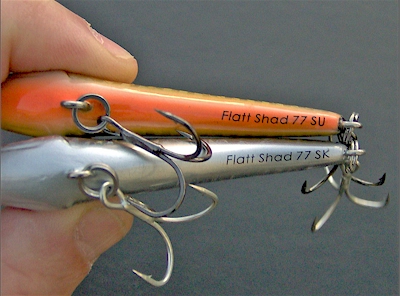
Both the Flatt Shad 77 SU and SK look identical, but you can tell
them apart by reading their tails. The SU will not sink. Instead
it suspends no more than two feet deep, making it ideal for
shallow cover.
However, the SK will sink as deep as you allow it. So the depth that the SK model reaches can vary from 3 or 4 feet to as many as 20 or 30 feet deep. It's versatile for shallow to deep.
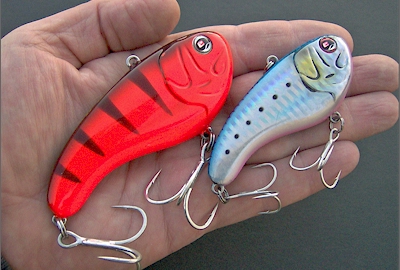
The huge Flatt Shad 96 SK (sinking) on left. The Flatt Shad 77 SK
on right. I wonder which one would a Mexican trophy bass favor
most?
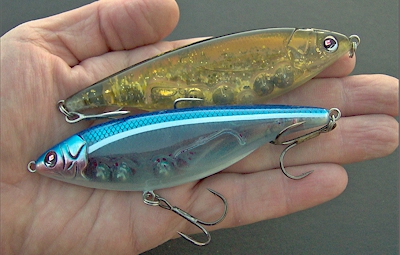
Next on queue for Mexico are Sebile's Stick Shadd 114 SK
(sinking) shown top, and Stick Shadd 114 SU (suspending) shown
bottom.
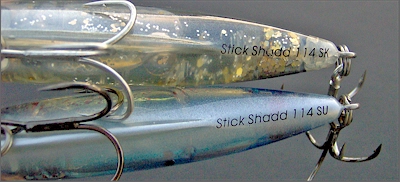
You guessed it, the 114's look alike, but are marked SK (sinking)
or SU (suspending) under their tails. The suspending model never
reaches more than a couple feet deep and excels in shallow cover.
However, the sinking model can be fished from shallow to as deep
as you reasonably desire.
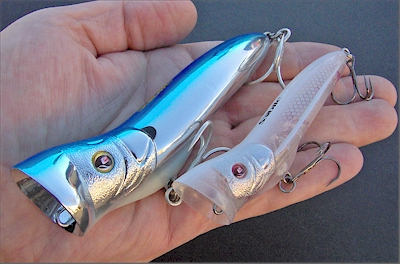
The size of the Splasher 120 (left) makes it selective for trophy
bass, and the Splasher 90 (right) is ideal for large numbers of
small to medium Mexican bass.
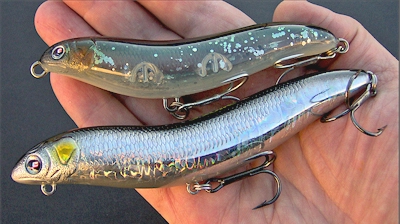
The size of the Ghost Walker 110 (top) is good for both quality
and quantity. The Slim Stick 138 (bottom) is big enough to be a
selective trophy bass tool.
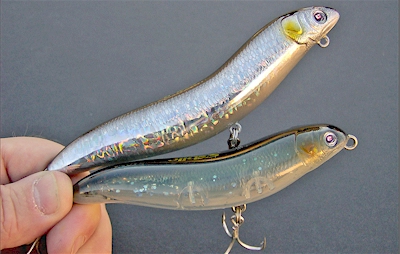
There they go again. Slim Stick 138 on top. Ghost Walker 110
below. Both surface walking baits.

Bonga Minnow 95 (left) and Bonga Minnow 125 (right). Topwater
doesn't get any better than this for numbers (Bonga Minnow 95) or
trophies (Bonga Minnow 125).

The Bonga Minnow 125 (left) shown again, with the Bonga Jerk 125.
Get the scale, tape measure and camera ready!
Note: The Bonga Minnow is a surface lure whereas the Bonga Jerk is a subsurface lure.
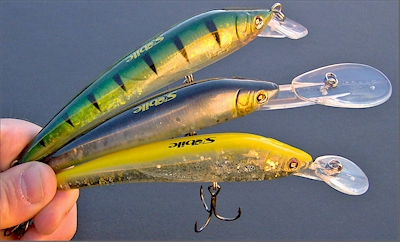
These unruly Koolies are big bass minnows. It may not be obvious
from the photo, but these are large minnow baits. Recommended for
Mexico, the Koolie Minnow ML 136 (top) is a trophy bass tool.
Koolie Minnow LL 118 (center) is for probing deep humps or
offshore structure. Koolie Minnow BRL 118 (bottom) is a shallow
cover version.
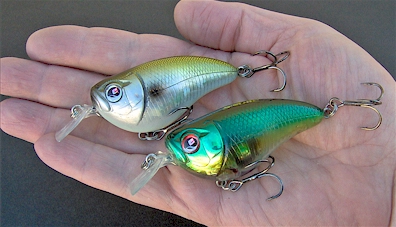
The Crankster 65 MR is a medium-runner that dives 4-6 feet. It's
a good crank for tough cover and stout gear. It rattles loudly.

The Crankster 65 MR is short but fat. It's actually beefier than
the photos here show. It is suited for relatively heavy gear.
When the time comes to replace its hooks, try the same size
replacements, but a little heavier hook wire gauge.
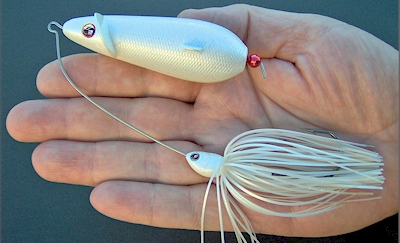
The Proppler Buzz floats and rattles. It can be buzzed steadily
up to or right through thick cover. It can crawl right over
bushes! It can also be paused adjacent to cover and ripped to
make a huge tear on the water surface. Be prepared for explosive
strikes when you rip it.

You really should bring a Sebile Onduspoon to Mexico! It's a
trophy bass bait, and works best when allowed to fall next to
cover while you give it small twitches to make it flop and flash
like a fluttering big baitfish.
I have summarized comments on each lure in the table below.
The column 'Mexican Numbers' means the lure would be suited to lakes or situations where large numbers of bass are caught, but rarely over 10 pounds.
The column 'Mexican Trophies' means the lure would be suited for lakes or situations where trophy bass (10 to 19 pounds) are common.
| Sebile Swimbaits | Mexican Numbers |
Mexican Trophies |
Notes pertaining to Mexico |
| Magic Swimmer 125 SSK | Numbers | Good smaller bait for 'finesse' in Mexico. Big up to #2 hooks. | |
| Magic Swimmer 145 FSK | Trophies | A winner! Excellent hooks! | |
| Magic Swimmer 165 SSK | Trophies | Proven winner! Excellent hooks! | |
| Magic Swimmer 228 SSK | Trophies | May not be a better trophy bass bait on the planet! | |
| Sebile Lipless | |||
| Flatt Shad 77 SU | Numbers | When hooks need replacement, you may want to replace with same size but heavier wire hooks. | |
| Flatt Shad 77 SK | Numbers | Good hooks for Mexico. Good size bait for Mexico. | |
| Flatt Shad 96 SK | Trophies | Great body size for trophies. Hooks actually a little heavy for Mexico. Anglers may want to replace hooks. | |
| Sebile Stick Baits | |||
| Stick Shadd 114 SU | Numbers | Trophies | Good size bait for Mexico. Good hooks for Mexico. |
| Stick Shadd 114 SK | Numbers | Trophies | Good size bait for Mexico. Good hooks for Mexico. |
| Sebile Topwater Lures | |||
| Splasher 90 | Numbers | Good body size. When time to replace hooks, you may want to use same size but heavier wire. | |
| Splasher 120 FW | Trophies | Great body size and great hooks for Mexican trophies. | |
| Ghost Walker 110 FW | Numbers | Trophies | Perfect body size and hooks for bass fishing in Mexico. |
| Slim Stick 138 FT | Trophies | Great body size and great hooks for Mexico. | |
| Bonga Minnow 95 | Numbers | Good hooks for Mexico. | |
| Bonga Minnow 125 FW | Trophies | Capable of landing the new Mexican record bass! | |
| Bonga Jerk | |||
| Bonga Jerk 125 FW | Trophies | Just awesome. Capable of landing the new Mexican record bass! | |
| Sebile Minnows | |||
| Koolie Minnow BRL 118 | Numbers | Good hooks for Mexico. | |
| Koolie Minnow LL 118 | Numbers | Good hooks for Mexico. | |
| Koolie Minnow ML 136 | Trophies | Has potential to be awesome, just awesome for Mexican trophy bass. | |
| Sebile Crankbaits | |||
| Crankster 65 MR | Numbers | Good body size. When time to replace hooks, you may want to use same size but heavier wire. | |
| Others | |||
| Onduspoon | Trophies | Looks good for Mexico. Great hook for landing trophies. | |
| Proppler Buzz | Numbers | Very, very good for heavy cover in Mexico. Will climb over and through brush. |
|
May I ask you for a favor please? Please start here first whenever you shop online. Click on any store logo above or Amazon.com book below. Bassdozer gets a small sales commission if you begin shopping at these stores from here. You always get the same low price you would pay anyway. Thank you kindly for shopping at Bassdozer.
Thank you for visiting. Please
enjoy! |